金刚狼3主题曲插曲片尾曲背景音乐MV歌词
DIN_EN__10305_1
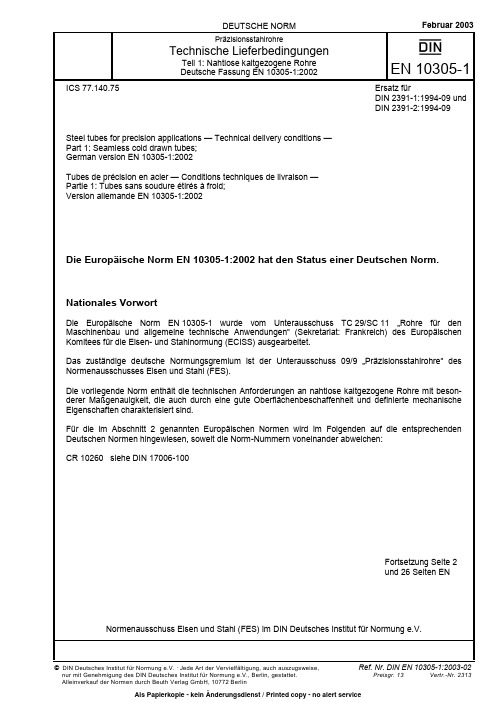
DEUTSCHE NORM Februar 2003Präzisionsstahlrohre Technische LieferbedingungenTeil 1: Nahtlose kaltgezogene RohreDeutsche Fassung EN 10305-1:2002EN 10305-1ICS 77.140.75Steel tubes for precision applications — Technical delivery conditions —Part 1: Seamless cold drawn tubes;German version EN 10305-1:2002Tubes de précision en acier — Conditions techniques de livraison —Partie 1: Tubes sans soudure étirés à froid;Version allemande EN 10305-1:2002Ersatz fürDIN 2391-1:1994-09 undDIN 2391-2:1994-09Die Europäische Norm EN 10305-1:2002 hat den Status einer Deutschen Norm.Nationales VorwortDie Europäische Norm EN 10305-1 wurde vom Unterausschuss TC 29/SC 11 …Rohre für den Maschinenbau und allgemeine technische Anwendungen“ (Sekretariat: Frankreich) des Europäischen Komitees für die Eisen- und Stahlnormung (ECISS) ausgearbeitet.Das zuständige deutsche Normungsgremium ist der Unterausschuss 09/9 …Präzisionsstahlrohre“ des Normenausschusses Eisen und Stahl (FES).Die vorliegende Norm enthält die technischen Anforderungen an nahtlose kaltgezogene Rohre mit beson-derer Maßgenauigkeit, die auch durch eine gute Oberflächenbeschaffenheit und definierte mechanische Eigenschaften charakterisiert sind.Für die im Abschnitt 2 genannten Europäischen Normen wird im Folgenden auf die entsprechenden Deutschen Normen hingewiesen, soweit die Norm-Nummern voneinander abweichen:CR 10260 siehe DIN 17006-100Fortsetzung Seite 2und 26 Seiten ENNormenausschuss Eisen und Stahl (FES) im DIN Deutsches Institut für Normung e.V.©DIN Deutsches Institut für Normung e.V. . Jede Art der Vervielfältigung, auch auszugsweise,Ref. Nr. DIN EN 10305-1:2003-02 nur mit Genehmigung des DIN Deutsches Institut für Normung e.V., Berlin, gestattet.Preisgr. 13Vertr.-Nr. 2313Alleinverkauf der Normen durch Beuth Verlag GmbH, 10772 BerlinDIN EN 10305-1:2003-02ÄnderungenGegenüber DIN 2391-1:1994-09 und DIN 2391-2:1994-09 wurden folgende Änderungen vorgenommen:a)Festlegungen für Maße und Technische Lieferbedingungen wurden in einer Norm zusammengefasst;b)Verwendung des Hauptsymbols 'E' (für Engineering steel / Maschinenbaustahl) statt 'S' (für Structuralsteel / Baustahl) in den Stahlkurznamen;c)die Stahlsorte S215GSiT/St 30 Si (1.0211) wurde gestrichen;d)Ersatz der Stahlsorten S215GAlT/St 30 Al (1.0212) durch E215, S235G2T/St 35 (1.0308) durch E235und S355GT/St 52 (1.0580) durch E355 bei Beibehaltung der bisherigen Werkstoffnummern;e)in einen normativen Anhang wurden die Stahlsorte St 45 (1.0408) als Sorte E255 sowie 11zusätzliche Stahlsorten aufgenommen;f)Festlegungen für chemische Zusammensetzung, mechanische Eigenschaften, Oberflächenbeschaf-fenheit, Maße, Prüfung und Kennzeichnung wurden überarbeitet.Frühere AusgabenDIN 2385: 1993-12DIN 2385-1: 1940-06, 1943-12, 1957-07DIN 2391: 1932-04DIN 2391-1: 1940-06, 1957-11, 1965-11, 1981-07, 1994-09DIN 2391-2: 1940-06, 1957-11, 1967-07, 1981-07, 1994-09Nationaler Anhang NA(informativ)LiteraturhinweiseDIN V 17006-100 (Vornorm), Bezeichnungssysteme für Stähle – Zusatzsymbole; Deutsche Fassung CR 10260:1998.2EUROPÄISCHE NORM EUROPEAN STANDARD NORME EUROPÉENNE EN 10305-1 November 2002ICS 77.140.75Deutsche FassungPräzisionsstahlrohreTechnische LieferbedingungenTeil 1: Nahtlose kaltgezogene RohreSteel tubes for precision applications – Technical delivery conditions – Part 1: Seamless cold drawn tubes Tubes de précision en acier – Conditions techniques de livraison – Partie 1: Tubes sans soudure étirés à froidDiese Europäische Norm wurde vom CEN am 2. Oktober 2002 angenommen.Die CEN-Mitglieder sind gehalten, die CEN/CENELEC-Geschäftsordnung zu erfüllen, in der die Bedingungen festgelegt sind, unter denen dieser Europäischen Norm ohne jede Änderung der Status einer nationalen Norm zu geben ist. Auf dem letzten Stand befindliche Listen dieser nationalen Normen mit ihren bibliographischen Angaben sind beim Management-Zentrum oder bei jedem CEN-Mitglied auf Anfrage erhältlich.Diese Europäische Norm besteht in drei offiziellen Fassungen (Deutsch, Englisch, Französisch). Eine Fassung in einer anderen Sprache, die von einem CEN-Mitglied in eigener Verantwortung durch Übersetzung in seine Landessprache gemacht und dem Management-Zentrum mitgeteilt worden ist, hat den gleichen Status wie die offiziellen Fassungen.CEN-Mitglieder sind die nationalen Normungsinstitute von Belgien, Dänemark, Deutschland, Finnland, Frankreich, Griechenland, Irland, Island, Italien, Luxemburg, Malta, Niederlande, Norwegen, Österreich, Portugal, Schweden, Schweiz, Spanien, der Tschechischen Republik und dem Vereinigten Königreich.EUROPÄISCHES KOMITEE FÜR NORMUNGEUROPEAN COMMITTEE FOR STANDARDIZATIONCOMITÉ EUROPÉEN DE NORMALISATIONManagement-Zentrum: rue de Stassart, 36 B-1050 Brüssel© 2002 CEN Alle Rechte der Verwertung, gleich in welcher Form und in welchemVerfahren, sind weltweit den nationalen Mitgliedern von CEN vorbehalten.Ref. Nr. EN 10305-1:2002 DEN 10305-1:2002 (D)InhaltSeite Vorwort (4)1Anwendungsbereich (5)2Normative Verweisungen (5)3Begriffe (6)4Symbole (6)5Einteilung und Bezeichnung (6)5.1Einteilung (6)5.2Bezeichnung (7)6Bestellangaben (7)6.1Verbindliche Angaben (7)6.2Optionen (7)6.3Bestellbeispiel (8)7Herstellverfahren (8)7.1Stahlherstellung (8)7.2Rohrherstellung und Lieferzustand (8)8Anforderungen (9)8.1Allgemeines (9)8.2Chemische Zusammensetzung (9)8.3Mechanische Eigenschaften (10)8.4Oberflächenbeschaffenheit und innere Beschaffenheit (11)8.4.1Oberflächenbeschaffenheit (11)8.4.2Innere Beschaffenheit (12)8.5Maße und Grenzabmaße (12)8.5.1Außendurchmesser, Innendurchmesser und Wanddicke (12)8.5.2Länge (15)8.5.3Geradheit (16)8.5.4Beschaffenheit der Rohrenden (16)9Prüfung (16)9.1Arten der Prüfung (16)9.2Prüfbescheinigungen (17)9.2.1Arten von Prüfbescheinigungen (17)9.2.2Inhalt der Prüfbescheinigungen (17)9.3Zusammenfassung der Prüfungen (17)10Probenahme (18)10.1Prüfeinheit (18)10.2Vorbereitung der Probenabschnitte und Proben (18)10.2.1Lage, Richtung und Vorbereitung der Probenabschnitte und Proben für die mechanischenPrüfungen (18)10.2.2Proben für Rauheitsmessungen (19)11Prüfverfahren (19)11.1Zugversuch (19)11.2Ringfaltversuch (19)11.3Aufweitversuch (20)11.4Maßkontrolle (20)11.5Rauheitsmessung (20)2EN 10305-1:2002 (D)Seite 11.6Sichtprüfung (20)11.7Zerstörungsfreie Prüfung (20)11.7.1Prüfung zum Nachweis von Längsfehlern (20)11.7.2Nachweis der Dichtheit (21)11.8Wiederholungsprüfungen, Sortieren und Nachbehandlung (21)12Kennzeichnung (21)13Oberflächenschutz und Verpackung (21)Anhang A (normativ) Anforderungen für zusätzliche Stahlsorten (22)Anhang B (informativ) Liste der entsprechenden früheren Symbole für den Lieferzustand und nationalen Stahlbezeichnungen (25)Literaturhinweise (26)3EN 10305-1:2002 (D)VorwortDieses Dokument EN 10305-1:2002 wurde vom Technischen Komitee ECISS/TC 29 “Stahlrohre und Fittings für Stahlrohre” erarbeitet, dessen Sekretariat von UNI gehalten wird.Dieses Europäische Dokument muss den Status einer nationalen Norm erhalten, entweder durch Veröffentlichung eines identischen Textes oder durch Anerkennung bis Mai 2003, und etwaige entgegenstehende nationale Normen müssen bis Mai 2003 zurückgezogen werden.Diese Europäische Norm besteht unter dem gemeinsamen Titel Präzisionsstahlrohre — Technische Lieferbe-dingungen aus sechs Teilen:Teil 1:Nahtlose kaltgezogene Rohre.Teil 2:Geschweißte kaltgezogene Rohre.Teil 3:Geschweißte maßgewalzte Rohre.Teil 4:Nahtlose kaltgezogene Rohre für Hydraulik- und Pneumatik-Druckleitungen.Teil 5:Geschweißte und maßumgeformte Rohre mit quadratischem oder rechteckigem Querschnitt.Teil 6:Geschweißte kaltgezogene Rohre für Hydraulik- und Pneumatik-Druckleitungen.In dieser Europäischen Norm ist Anhang A normativ, und Anhang B ist informativ.Dieses Dokument enthält einen Abschnitt Literaturhinweise.Entsprechend der CEN/CENELEC-Geschäftsordnung sind die nationalen Normungsinstitute der folgenden Länder gehalten, diese Europäische Norm zu übernehmen : Belgien, Dänemark, Deutschland, Finnland, Frankreich, Griechenland, Irland, Island, Italien, Luxemburg, Malta, Niederlande, Norwegen, Österreich, Portugal, Schweden, Schweiz, Spanien, die Tschechische Republik und das Vereinigte Königreich.4EN 10305-1:2002 (D)1 AnwendungsbereichDieser Teil der EN 10305 enthält die technischen Lieferbedingungen für nahtlose kaltgezogene Präzisions-rohre aus Stahl mit kreisförmigem Querschnitt.ANMERKUNG Dieser Teil der EN 10305 kann auch für andere Querschnitte gelten.Rohre nach diesem Teil der EN 10305 sind durch genau definierte Grenzabmaße und eine festgelegte Oberflächenrauheit charakterisiert. Typische Anwendungsgebiete sind der Fahrzeugbau, die Möbelindustrie und der Allgemeine Maschinenbau.2 Normative VerweisungenDiese Europäische Norm enthält durch datierte oder undatierte Verweisungen Festlegungen aus anderen Publikationen. Diese normativen Verweisungen sind an den jeweiligen Stellen im Text zitiert, und die Publikationen sind nachstehend aufgeführt. Bei datierten Verweisungen gehören spätere Änderungen oderÜberarbeitungen dieser Publikationen nur dann zu dieser Europäischen Norm, falls sie durch Änderung oder Überarbeitung eingearbeitet sind. Bei undatierten Verweisungen gilt die letzte Ausgabe der in Bezug genommenen Publikation (einschließlich Änderungen).EN 10002-1, Metallische Werkstoffe — Zugversuch — Teil 1: Prüfverfahren bei Raumtemperatur.EN 10020, Begriffsbestimmungen für die Einteilung der Stähle.EN 10021, Allgemeine Technische Lieferbedingungen für Stahl und Stahlerzeugnisse.EN 10027-1, Bezeichnungssysteme für Stähle — Teil 1: Kurznamen, Hauptsymbole.EN 10027-2, Bezeichnungssysteme für Stähle — Teil 2: Nummernsystem.EN 10052, Begriffe der Wärmebehandlung von Eisenwerkstoffen.prEN 101681) , Stahlerzeugnisse — Prüfbescheinigungen — Liste und Beschreibung der Angaben.EN 10204, Metallische Erzeugnisse — Arten von Prüfbescheinigungen.ENV 10220, Nahtlose und geschweißte Stahlrohre — Maße und längenbezogene Masse.EN 10233, Metallische Werkstoffe — Rohr — Ringfaltversuch.EN 10234, Metallische Werkstoffe — Rohr – Aufweitversuch.EN 10246-1, Zerstörungsfreie Prüfung von Stahlrohren — Teil 1: Automatische elektromagnetische Prüfung nahtloser und geschweißter (ausgenommen unterpulvergeschweißter) ferromagnetischer Stahlrohre zum Nachweis der Dichtheit.EN 10246-3, Zerstörungsfreie Prüfung von Stahlrohren — Teil 3: Automatische Wirbelstromprüfung nahtloser und geschweißter (ausgenommen unterpulvergeschweißter) Stahlrohre zum Nachweis von Fehlern.1)In Vorbereitung; bis zu ihrer Veröffentlichung als Europäische Norm sollte eine entsprechende nationale Norm zumZeitpunkt der Anfrage und Bestellung vereinbart werden.5EN 10305-1:2002 (D)EN 10246-5,Zerstörungsfreie Prüfung von Stahlrohren — Teil 5: Automatische Magnetfeldsonden-Streufluss-prüfung nahtloser und geschweißter (ausgenommen unterpulvergeschweißter) ferromagnetischer Stahlrohre über den gesamten Rohrumfang zum Nachweis von Längsfehlern.EN 10246-7, Zerstörungsfreie Prüfung von Stahlrohren — Teil 7: Automatische Ultraschallprüfung nahtloser und geschweißter (ausgenommen unterpulvergeschweißter) Stahlrohre über den gesamten Rohrumfang zum Nachweis von Längsfehlern.EN 10256, Zerstörungsfreie Prüfung — Qualifizierung und Kompetenz von Personal der Stufen 1 und 2 für die zerstörungsfreie Prüfung.prEN 102661), Stahlrohre, Fittings und Hohlprofile für den Stahlbau — Symbole und Definition von Begriffen für die Verwendung in Erzeugnisnormen.EN ISO 377, Stahl und Stahlerzeugnisse — Lage und Vorbereitung von Probenabschnitten und Proben für mechanische Prüfungen (ISO 377:1997).EN ISO 2566-1, Stahl — Umrechnung von Bruchdehnungswerten — Teil 1: Unlegierte und niedriglegierte Stähle (ISO 2566-1:1984).EN ISO 4287, Geometrische Produktspezifikationen (GPS) — Oberflächenbeschaffenheit: Tastschnitt-verfahren — Benennungen, Definitionen und Kenngrößen der Oberflächenbeschaffenheit (ISO 4287:1997). CR 10260, Bezeichnungssysteme für Stähle — Zusatzsymbole 2) .3 BegriffeFür die Anwendung dieser Europäischen Norm gelten die Begriffe in EN 10020, EN 10021, EN 10052 und prEN 10266 und folgender Begriff:3.1ArbeitgeberUnternehmen, in dem eine Person tätig istANMERKUNG Arbeitgeber kann entweder der Rohrhersteller sein oder eine dritte Partei, die zerstörungsfreie Prüfungen (ZfP) durchführt.4 SymboleSiehe prEN 10266.ANMERKUNG In diesem Teil der EN 10305 ist …T“ die Nennwanddicke oder die berechnete Wanddicke.5 Einteilung und Bezeichnung5.1 EinteilungNach dem Einteilungssystem in EN 10020 sind die in Tabelle 2 aufgeführten Stähle unlegierte Qualitätsstähle.1)In Vorbereitung; bis zu ihrer Veröffentlichung als Europäische Norm sollte eine entsprechende nationale Norm zumZeitpunkt der Anfrage und Bestellung vereinbart werden.6EN 10305-1:2002 (D) Bei den Stählen nach Tabelle A.1 handelt es sich um unlegierte Qualitätsstähle (E255, E410, 26Mn5, 10S10, 15S10, 18S10 und 37S10), unlegierte Edelstähle (C35E und C45E) und legierte Edelstähle (26Mo2, 25CrMo4 und 42CrMo4).5.2 BezeichnungFür die Rohre nach diesem Teil der EN 10305 umfasst die Stahlbezeichnung:die Nummer dieses Teils der EN 10305 (EN 10305-1)sowie entwederden Kurznamen nach EN 10027-1 und CR 10260oderdie Werkstoffnummer nach EN 10027-2.6 Bestellangaben6.1 Verbindliche AngabenDer Besteller muss bei der Anfrage und Bestellung folgende Angaben machen:a) Bestellmenge (Masse oder Gesamtlänge oder Stückzahl);b) Begriff …Rohr“;c) Maße (siehe 8.5);d) Bezeichnung nach diesem Teil der EN 10305 (siehe 5.2);e) Lieferzustand einschließlich der Oberflächenbeschaffenheit (siehe 7.2.1 und 7.2.2);f) Art der Rohrlänge und, soweit anwendbar, Länge (siehe 8.5.2).6.2 OptionenEine Reihe von Optionen ist in diesem Teil der EN 10305 festgelegt und nachstehend aufgeführt. Sollte der Besteller bei der Anfrage und Bestellung keinen Wunsch äußern, von den entsprechenden Optionen Gebrauch zu machen, so sind die Rohre in Übereinstimmung mit den Grundfestlegungen zu liefern (siehe 6.1).1) Festlegung einer Stahlsorte, die in diesem Teil der EN 10305 nicht spezifiziert ist (siehe 8.2);2) Festlegung eines Bereiches für den Schwefelanteil zur Verbesserung der Zerspanbarkeit (siehe 8.2);3) Oberflächenbeschaffenheit für die Weiterverarbeitung (siehe 8.4.1.1);4) Messung der Oberflächenrauheit (siehe 8.4.1.5);5) Verminderte Oberflächenrauheit (siehe 8.4.1.5);6) Definition der von der Oberfläche entfernbaren Stoffe (siehe 8.4.1.6);7) Zerstörungsfreie Prüfung zum Nachweis von Längsfehlern (siehe 8.4.2);7EN 10305-1:2002 (D)88) Zerstörungsfreie Prüfung zum Nachweis der Dichtheit (siehe 8.4.2);9) Festlegung eines nichtkreisförmigen Querschnitts (siehe 8.5.1.1);10) Festlegung der Rohre nach Außen- oder Innendurchmesser und Wanddicke (siehe 8.5.1.1);11) Verminderte Durchmesser-Grenzabmaße (siehe 8.5.1.2);12) Einseitige Durchmesser-Grenzabmaße (siehe 8.5.1.2);13) Verminderte Abweichungen von der Konzentrizität (siehe 8.5.1.3);14) Verminderte Wanddicken-Grenzabmaße (siehe 8.5.1.4);15) Einseitige Wanddicken-Grenzabmaße (siehe 8.5.1.4);16) Vereinbarung von Grenzabmaßen für Genaulängen ≤ 500 mm oder > 8000 mm (siehe Tabelle 7);17) Besondere Endenbearbeitung (siehe 8.5.4);18) Spezifische Prüfung (siehe 9.1);19) Abnahmeprüfzeugnis 3.1.A oder 3.1.C (siehe 9.2.1);20) Ringfalt- oder Aufweitversuch (siehe Tabelle 8);21) Prüfeinheit mit Rohren aus nur einer Schmelze (siehe 10.1);22) Alternative Kennzeichnung (siehe Abschnitt 12);23) Lieferung ohne Korrosionsschutz (siehe Abschnitt 13);24) Festgelegter Korrosionsschutz (siehe Abschnitt 13);25) Festgelegtes Verpackungsverfahren (siehe Abschnitt 13).6.3 Bestellbeispiel12 000 m Rohre mit einem Außendurchmesser von 60 mm und einem Innendurchmesser von 56 mm nach diesem Teil der EN 10305, gefertigt aus der Stahlsorte E235 im normalgeglühten Zustand, geliefert in Herstelllängen mit einem Abnahmeprüfzeugnis 3.1.B nach EN 10204:12 000 m Rohre — 60xID56 — EN 10305-1 — E235+N — Herstelllänge — Option 18.7 Herstellverfahren7.1 StahlherstellungDie Wahl des Stahlherstellungsverfahrens ist dem Hersteller überlassen.Der Stahl muss vollberuhigt sein.7.2 Rohrherstellung und Lieferzustand7.2.1Die Rohre sind aus warmgefertigten nahtlosen Rohren durch Kaltziehen oder andere geeignete Verfahren herzustellen.EN 10305-1:2002 (D) 7.2.2Die Rohre sind in einem der in Tabelle 1 angegebenen Lieferzustände zu liefern.Tabelle 1 — LieferzustandBezeichnung Symbol a Beschreibungzugblank/hart+C Ohne Wärmebehandlung nach dem abschließendenKaltziehen.zugblank/weich+LC Nach der letzten Wärmebehandlung folgt in geeigneterWeise ein Kaltziehen in einem Stich.zugblank und spannungsarmgeglüht+SR Nach dem letzten Kaltziehen wird unter kontrollierterAtmosphäre spannungsarmgeglüht.geglüht+A Nach dem letzten Kaltziehen werden die Rohre unterkontrollierter Atmosphäre geglüht.normalgeglüht+N Nach dem letzten Kaltziehen werden die Rohre unterkontrollierter Atmosphäre normalgeglüht.a Die früher häufig verwendeten entsprechenden Symbole der Wärmebehandlung werden in Tabelle B.1 angegeben.7.2.3Alle Tätigkeiten der zerstörungsfreien Prüfung (ZfP) sind durch qualifiziertes und kompetentes Personal der Stufen 1, 2 und/oder 3, das vom Arbeitgeber dafür bestätigt wurde, auszuführen. Die Qualifizierung muss nach EN 10256 oder nach zumindest gleichwertiger Spezifikation erfolgt sein.Empfohlenerweise sollte das Personal der Stufe 3 nach EN 473 oder nach zumindest gleichwertiger Spezifikation zertifiziert sein.Die Autorisierung für die Durchführung der Prüfungen durch den Arbeitgeber muss auf der Grundlage einer schriftlichen Anweisung erteilt werden. Die ZfP-Operationen müssen von einer vom Arbeitgeber bestätigten Person der ZfP-Stufe 3 autorisiert sein.ANMERKUNG Die Definition der Stufen 1, 2 und 3 kann geeigneten Spezifikationen, z. B. EN 473 und EN 10256, ent-nommen werden.8 Anforderungen8.1 AllgemeinesDie Rohre müssen die Anforderungen dieses Teils der EN 10305 erfüllen, soweit sie in einem in Tabelle 1 angegebenen Lieferzustand geliefert und in Übereinstimmung mit den Abschnitten 9, 10 und 11 geprüft werden.Zusätzlich gelten die in EN 10021 festgelegten allgemeinen technischen Lieferbedingungen.8.2 Chemische ZusammensetzungFür die Schmelzenanalyse gelten die vom Stahlhersteller gelieferten Werte, die die Anforderungen nach Tabelle 2 (siehe aber Optionen 1 und 2) oder nach Tabelle A.1 erfüllen müssen. Eine Stahlsorte, die in diesem Teil der EN 10305 nicht spezifiziert ist, darf festgelegt werden (siehe Option 1).Option 1:Eine in diesem Teil der EN 10305 nicht spezifizierte Stahlsorte mit einem Höchstanteil an Legierungselementen von 5 % ist festgelegt. Chemische Zusammensetzung, mechanische Eigenschaften und Lieferzustand sind durch den Besteller festzulegen.ANMERKUNG Beim Schweißen von Rohren, die nach diesem Teil der EN 10305 hergestellt wurden, sollte die Tatsache berücksichtigt werden, dass das Verhalten des Stahles während und nach dem Schweißen nicht nur von der Stahlsorte und dem Lieferzustand, sondern auch davon abhängt, wie das Schweißen vorbereitet und durchgeführt wird.9 Als Papierkopie - kein Änderungsdienst / Printed copy - no alert serviceEN 10305-1:2002 (D)10Tabelle 2 — Chemische Zusammensetzung (Schmelzenanalyse) aStahlsorte Massenanteile in %C Si Mn P S b Al Kurzname Werkstoffnummermax.max.max.max.max.min.E215 1.02120,100,050,700,0250,0250,025 E235 1.03080,170,351,200,0250,025—E355c 1.05800,220,551,600,0250,025—a Elemente, die in dieser Tabelle nicht erwähnt sind, dürfen dem Stahl, mit Ausnahme von Elementen zum Fertigbehandeln derSchmelze, ohne Zustimmung des Bestellers nicht absichtlich zugegeben werden. Es sind alle angemessenen Vorkehrungen zu treffen, um die Zufuhr unerwünschter Elemente aus dem Schrott oder anderen Einsatzstoffen, die bei der Stahlherstellung verwendet werden, zu vermeiden, siehe Option 2.b Siehe Option 2.c Zugaben von Nb, Ti und V sind zulässig nach Wahl des Herstellers. Der Anteil dieser Elemente ist anzugeben.Option 2:Für die Stahlsorten E235 und E355 ist ein kontrollierter Schwefelanteil von 0,015 % bis 0,040 % zur Verbesserung der Zerspanbarkeit festgelegt. Er ist durch Wiederaufschwefelung des Stahles nach maximaler Entschwefelung oder alternativ durch sekundärmetallurgische Verfahren mit Absenkung des Sauerstoffanteils einzustellen.Tabelle 3 enthält die Grenzabweichungen der Stückanalyse von den in Tabelle 2 festgelegten Grenzwerten der Schmelzenanalyse.Tabelle 3 — Grenzabweichungen der Stückanalyse von den in Tabelle 2 festgelegtenGrenzwerten der SchmelzenanalyseElement Grenzwert der Schmelzenanalysenach Tabelle 2Massenanteile in %Grenzabweichungen der StückanalyseMassenanteile in %C≤ 0,22+ 0,02Si≤ 0,55+ 0,05Mn≤ 1,60+ 0,10P≤ 0,025+ 0,005S≤ 0,040± 0,005Al≥ 0,025- 0,0058.3 Mechanische EigenschaftenDie mechanischen Eigenschaften der Rohre müssen die Anforderungen nach Tabelle 4, Tabelle A.3 und, soweit anwendbar, 11.2 und 11.3 erfüllen.ANMERKUNG Eine nachfolgende Behandlung (kalt oder warm) kann die mechanischen Eigenschaften ändern.Als Papierkopie - kein Änderungsdienst / Printed copy - no alert serviceEN 10305-1:2002 (D)11Tabelle 4 — Mechanische Eigenschaften bei RaumtemperaturStahlsorte Mindestwerte für den Lieferzustand a,b+C c+LCd+SR+Ad+NKurz-nameWerkstoff-nummerR m MPaA %R m MPa A %R m MPa R eH MPa A %R m MPa A %R m MPa R eHeMPa A %E215 1.02124308380123802801628030290 bis 43021530E235 1.03084806420104203501631525340 bis 48023525E3551.058064045807580450f1045022490 bis 63035522aR m : Zugfestigkeit; R eH : obere Streckgrenze (siehe aber 11.1); A : Bruchdehnung; wegen der Symbole für den Lieferzustand siehe Tabelle 1.b1 MPa = 1 N/mm 2.cIn Abhängigkeit vom Kaltumformgrad im letzten Stich kann die Streckgrenze bis nahe an die Zugfestigkeit heranreichen. Für Berechnungszwecke werden folgende Verhältniswerte empfohlen:—Lieferzustand +C: R eH ≥ 0,8 R m —Lieferzustand +LC: R eH ≥ 0,7 R m .d Für Berechnungszwecke wird der folgende Verhältniswert empfohlen: R eH ≥ 0,5 R m .eBei Rohren mit einem Außendurchmesser ≤ 30 mm und einer Wanddicke ≤ 3 mm sind die R eH -Mindestwerte um 10 MPa niedriger als in dieser Tabelle angegeben.fBei Rohren mit einem Außendurchmesser > 160 mm gilt: R eH ≥ 420 MPa.8.4 Oberflächenbeschaffenheit und innere Beschaffenheit8.4.1 Oberflächenbeschaffenheit8.4.1.1Die Rohre müssen den für das Herstellverfahren und – soweit zutreffend – für die angewendete Wärmebehandlung typischen Zustand der inneren und äußeren Oberfläche aufweisen. Der Oberflächen-zustand muss das Auffinden von Oberflächenunregelmäßigkeiten wie Riefen, Beulen oder Einkerbungen, die ein Nachbearbeiten erfordern, zulassen.Option 3: Eine für die Weiterverarbeitung geeignete Oberflächenbeschaffenheit ist durch den Besteller fest-gelegt.8.4.1.2Oberflächenunregelmäßigkeiten, deren Tiefe nicht eindeutig identifiziert werden kann (d. h. Zunder,Überwalzungen), sind nach 8.4.1.3 zu entfernen oder nach 8.4.1.4 zu behandeln.8.4.1.3Oberflächenunregelmäßigkeiten dürfen nur durch Schleifen oder spanende Bearbeitung nach-bearbeitet werden, soweit die festgelegten Grenzabmaße eingehalten werden. Alle nachbearbeiteten Bereiche müssen glatt in die Rohrkontur übergehen.8.4.1.4Oberflächenunregelmäßigkeiten, die zur Unterschreitung der festgelegten Mindestwanddicke führen, sind als Fehler zu betrachten. Rohre, die diese Fehler enthalten, erfüllen nicht die Festlegungen dieses Teils der EN 10305.8.4.1.5Die Rohre müssen eine glatte äußere und innere Oberfläche aufweisen. Die Rauheit R a muss betragen:≤ 4 µm für die äußere Oberfläche von Rohren im Lieferzustand +SR, +A und +N; ≤ 4 µm für äußere und innere Oberfläche von Rohren im Lieferzustand +C und +LC.Der Nachweis der Oberflächenrauheit und/oder niedrigere Rauheitswerte kann/können festgelegt werden (siehe Optionen 4 und 5).ANMERKUNGFür die innere Oberfläche gilt diese Anforderung bei einem Innendurchmesser ≥ 15 mm.Als Papierkopie - kein Änderungsdienst / Printed copy - no alert serviceEN 10305-1:2002 (D)Option 4: Die Oberflächenrauheit ist zu messen und anzugeben.Option 5: Für die Rohre gilt eine festgelegte Oberflächenrauheit. Art und Grenzwert der Rauheit sind bei der Anfrage und Bestellung zu vereinbaren. Die Rauheit ist zu messen und anzugeben.8.4.1.6Rohre im Lieferzustand +C oder +LC weisen üblicherweise dünne Schichten von Schmiermitteln und Schmiermittelträgern von der Kaltfertigung auf.Option 6: Auf den Rohroberflächen dürfen sich nur solche Reststoffe befinden, die sich bei der Rohrweiter-verarbeitung leicht entfernen lassen. Besondere Anforderungen müssen vereinbart werden.Rohre im Lieferzustand +SR können dünne Schichten von Schmiermitteln und Schmiermittelträgern aufweisen, die sich während des Spannungsarmglühens teilweise umwandeln. Rohre im Lieferzustand +SR, +A oder +N müssen frei von losem Zunder sein, dürfen aber Verfärbungen aufweisen.8.4.2 Innere BeschaffenheitDer Nachweis der inneren Beschaffenheit durch zerstörungsfreie Prüfung kann durch den Besteller festgelegt werden (siehe Optionen 7 und 8).Option 7: Die zerstörungsfreie Prüfung zum Nachweis von Längsfehlern ist nach 11.7.1 durchzuführen. Option 8: Die zerstörungsfreie Prüfung zum Nachweis der Dichtheit ist nach 11.7.2 durchzuführen.8.5 Maße und Grenzabmaße8.5.1 Außendurchmesser, Innendurchmesser und Wanddicke8.5.1.1Kreisförmige Rohre (siehe aber Option 9) sind nach Außendurchmesser und Innendurchmesser festzulegen, wenn nicht Option 10 festgelegt ist.Option 9: Ein vereinbarter nichtkreisförmiger Querschnitt ist festgelegt.Option 10:Die Rohre sind nach Außendurchmesser und Wanddicke oder nach Innendurchmesser und Wanddicke festgelegt.8.5.1.2Vorzugsmaße für Durchmesser und Wanddicke, die mit geringen Abweichungen auf den Maßen in ENV 10220 basieren, sowie Durchmesser-Grenzabmaße enthält Tabelle 5.Für Zwischenmaße gelten jeweils die Grenzabmaße des nächstgrößeren Rohrformats.In den Durchmesser-Grenzabmaßen ist die Unrundheit enthalten.Die Durchmesser-Grenzabmaße in Tabelle 5 gelten für Rohre im Lieferzustand +C oder +LC. Für wärmebe-handelte Rohre im Lieferzustand +SR, +A und +N sind die entsprechenden Grenzabmaße in Abhängigkeit vom Verhältnis Wanddicke zu Außendurchmesser unter Berücksichtigung der Korrekturfaktoren in Tabelle 6 gegeben. Andere Durchmesser-Grenzabmaße können festgelegt werden (siehe Optionen 11 und 12).12Als Papierkopie - kein Änderungsdienst / Printed copy - no alert service。
DIN_EN_10216-1_2004-07
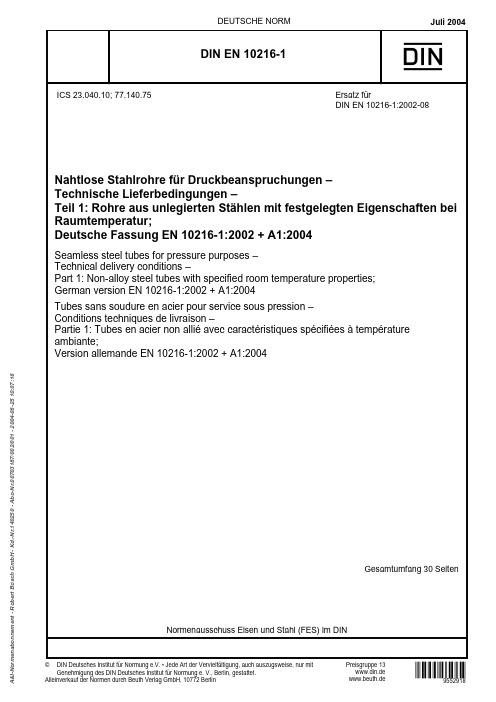
Angaben über zulässige Betriebsdrücke nicht enthalten; jeweils zwei Güten je Festigkeitsstufe mit unterschiedlichem Anforderungsniveau festgelegt; Stahlsorten mit ReH = 355 MPa (St 52.0 bzw. St 52.4) sind entfallen, Stahlsorte mit ReH = 195 MPa wurde zusätzlich aufgenommen; Kurznamen und Werkstoffnummern geändert; Festlegungen für die chemische Zusammensetzung und mechanische Eigenschaften teilweise geändert; Anhaltswerte für die 0,2%-Dehngrenze bei erhöhten Temperaturen nicht angegeben; Grenzabmaße für Außendurchmesser, Wanddicke und Länge teilweise geändert; Prüfumfang geändert; Ringversuche nicht festgelegt; Option für den Kerbschlagbiegeversuch bei − 10 °C in Längsrichtung festgelegt; Option für Wanddickenmessung außerhalb des Rohrendenbereichs festgelegt; Anwendbarkeit der elektromagnetischen Dichtheitsprüfung erweitert; redaktionelle Änderungen.
雷神3主题曲、插曲、片尾曲、背景音乐所有歌曲mv歌词
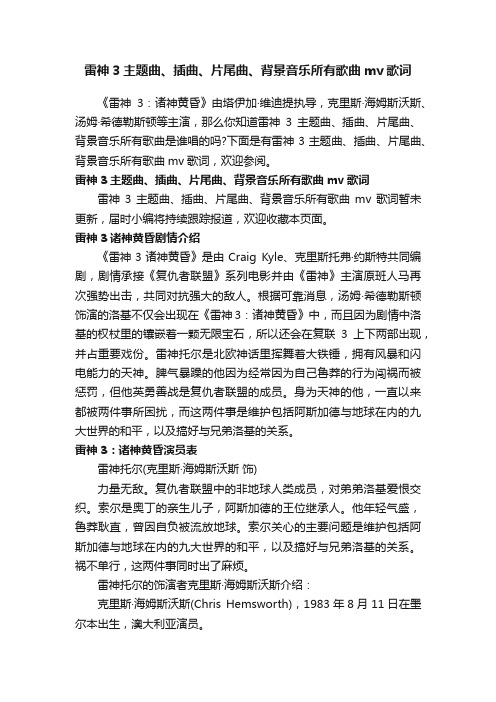
雷神3主题曲、插曲、片尾曲、背景音乐所有歌曲mv歌词《雷神3:诸神黄昏》由塔伊加·维迪提执导,克里斯·海姆斯沃斯、汤姆·希德勒斯顿等主演,那么你知道雷神3主题曲、插曲、片尾曲、背景音乐所有歌曲是谁唱的吗?下面是有雷神3主题曲、插曲、片尾曲、背景音乐所有歌曲mv歌词,欢迎参阅。
雷神3主题曲、插曲、片尾曲、背景音乐所有歌曲mv歌词雷神3主题曲、插曲、片尾曲、背景音乐所有歌曲mv歌词暂未更新,届时小编将持续跟踪报道,欢迎收藏本页面。
雷神3诸神黄昏剧情介绍《雷神3诸神黄昏》是由Craig Kyle、克里斯托弗·约斯特共同编剧,剧情承接《复仇者联盟》系列电影并由《雷神》主演原班人马再次强势出击,共同对抗强大的敌人。
根据可靠消息,汤姆·希德勒斯顿饰演的洛基不仅会出现在《雷神3:诸神黄昏》中,而且因为剧情中洛基的权杖里的镶嵌着一颗无限宝石,所以还会在复联3上下两部出现,并占重要戏份。
雷神托尔是北欧神话里挥舞着大铁锤,拥有风暴和闪电能力的天神。
脾气暴躁的他因为经常因为自己鲁莽的行为闯祸而被惩罚,但他英勇善战是复仇者联盟的成员。
身为天神的他,一直以来都被两件事所困扰,而这两件事是维护包括阿斯加德与地球在内的九大世界的和平,以及搞好与兄弟洛基的关系。
雷神3:诸神黄昏演员表雷神托尔(克里斯·海姆斯沃斯饰)力量无敌。
复仇者联盟中的非地球人类成员,对弟弟洛基爱恨交织。
索尔是奥丁的亲生儿子,阿斯加德的王位继承人。
他年轻气盛,鲁莽耿直,曾因自负被流放地球。
索尔关心的主要问题是维护包括阿斯加德与地球在内的九大世界的和平,以及搞好与兄弟洛基的关系。
祸不单行,这两件事同时出了麻烦。
雷神托尔的饰演者克里斯·海姆斯沃斯介绍:克里斯·海姆斯沃斯(Chris Hemsworth),1983年8月11日在墨尔本出生,澳大利亚演员。
2011年,克里斯出演了好莱坞电影《雷神》,并凭借雷神一角成为好莱坞明星。
IEC-PAS-61755-3-32-2007
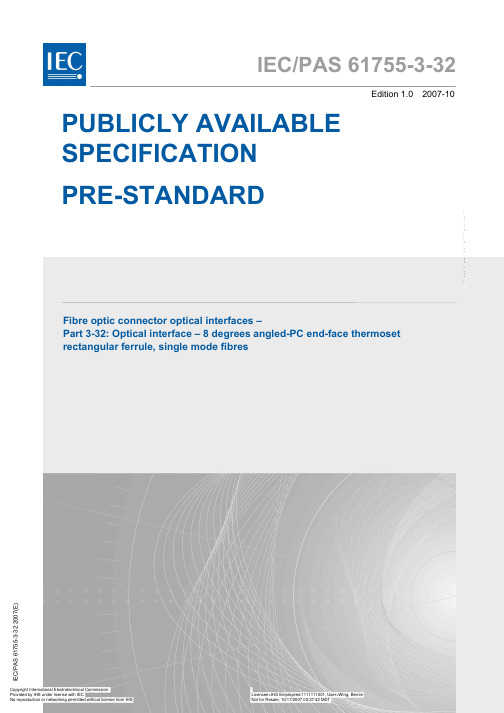
NOITACIFICEPS ELBALIAVA YLCILBUP
01-7002
DRADNATS-ERP
23-3-55716 SAP/CEI
0.1 noitidE
TDM 24:73:30 7002/71/01 ,elaseR rof toN einreB ,gniW=resU ,1001111111/seeyolpmE SHI=eesneciL
hc.cei.www :be W h c. c e i@ l i a m n i : l i a m E d n a l r ez t i w S 0 2 a v en eG 112 1- HC ébmeraV ed eur ,3 e c iffO l a rt n e C CEI . n o i t a mr o f n i r e h t r u f r o f e e t t i m m o C l a n o it a N r e b m e m C E I l a c o l r u o y r o w o l e b s s e r d d a e h t t c a t n o c e s a e l p , no i t ac i l b u p s i ht ot st h gi r l an o it id d a gn i n i at b o t u o b a yr iu q n e n a e v a h r o t h g i ry p o c CEI t u o b a s n o it s e u q y n a e v a h u oy fI
0 0 30 9 1 9 2 2 1 4 + :x a F 1 1 2 0 91 9 2 2 1 4 + : . l e T hc. ce i @csc :l i amE :s u tc atn oc r o QAF e rtne C e c i v r e S r e m ot s u C e ht t i si v e s a el p , e c n at s i s s a re ht r u f d ee n r o n o it a c il b u p s i ht n o k c a b d e e f r u oy s u e v i g ot h s iw u oy fI v r e s t s u c / e r o t s b e w / h c . c e i . w w w : e r t n e C ec i v r e S r e m o t s u C �
辛迪控制系统SIMATIC PCS neo功能库手册说明书
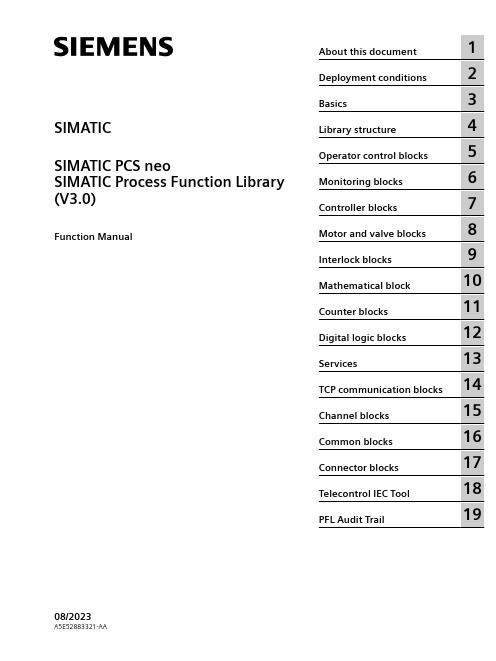
5
Monitoring blocks
6
Controller blocks
7
Motor and valve blocks
8
Interlock blocks
9
Mathematical block
10
Counter blocks
11
Digital logic blocks
12
Services
13
14 TCP communication blocks
SIMATIC SIMATIC PCS neo SIMATIC Process Function Library (V3.0)
Function Manual
About this document
1
Deployment conditions
2
Basics
3
Library structure
4
Operator control blocks
CAUTION
indicates that minor personal injury can result if proper precautions are not taken.
NOTICE
indicates that property damage can result if proper precautions are not taken. If more than one degree of danger is present, the warning notice representing the highest degree of danger will be used. A notice warning of injury to persons with a safety alert symbol may also include a warning relating to property damage.
惠威HR70遥控器使用说明书
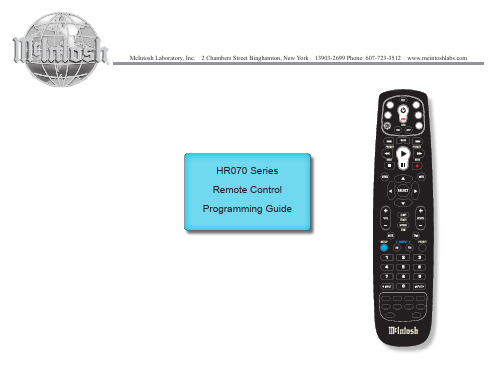
HR070 Series Remote Control Programming Guide
6. Repeat steps 1 to 5 for the other components you want to control. For future reference, write down each working component code below:
HR Series Remote Control Programming
Assigned Push-button Component Program Code
TV
CBL
SAT
AUX
DVR
Push-buttons available for Programming
Flashes during Programming
4
Used to activate Programming Mode
with the most popular code first. If the component
responds, go to step 7.
6. If the component does not respond, press LEVEL+
Push-button and the Remote Control will test
The HR70 Series Remote Controls have stored in permanent memory the necessary information to send the correct commands to the component to be controlled. By entering a five digit numeric code the commands for controlling the component is activated.
DIN_EN_10253-3
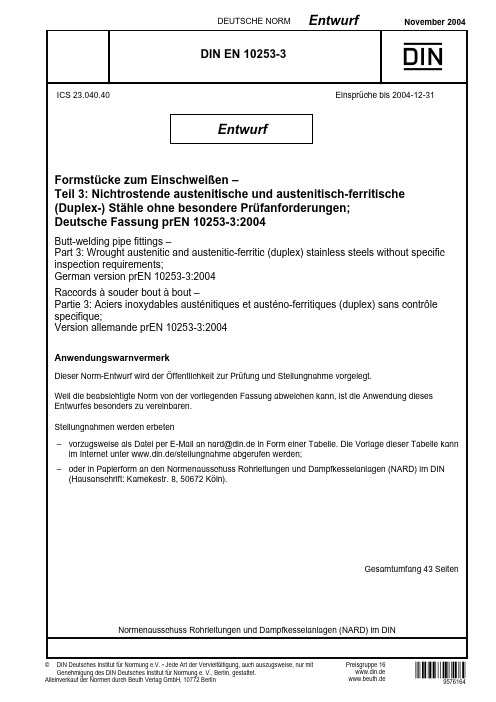
November 2004DEUTSCHE NORM Entwurf Normenausschuss Rohrleitungen und Dampfkesselanlagen (NARD) im DINPreisgruppe 16DIN Deutsches Institut für Normung e.V. • Jede Art der Vervielfältigung, auch auszugsweise, nur mitGenehmigung des DIN Deutsches Institut für Normung e. V., Berlin, gestattet.ICS 23.040.40Dieser Norm-Entwurf wird der Öffentlichkeit zur Prüfung und Stellungnahme vorgelegt.Weil die beabsichtigte Norm von der vorliegenden Fassung abweichen kann, ist die Anwendung diesesEntwurfes besonders zu vereinbaren.Stellungnahmen werden erbetenAnwendungswarnvermerk?CF 9576164www.din.de X –vorzugsweise als Datei per E-Mail an nard@din.de in Form einer Tabelle. Die Vorlage dieser Tabelle kann im Internet unter www.din.de/stellungnahme abgerufen werden;–oder in Papierform an den Normenausschuss Rohrleitungen und Dampfkesselanlagen (NARD) im DIN (Hausanschrift: Kamekestr. 8, 50672 Köln).EntwurfDIN EN 10253-3Formstücke zum Einschweißen –Teil 3: Nichtrostende austenitische und austenitisch-ferritische(Duplex-) Stähle ohne besondere Prüfanforderungen;Deutsche Fassung prEN 10253-3:2004Butt-welding pipe fittings –Part 3: Wrought austenitic and austenitic-ferritic (duplex) stainless steels without specific inspection requirements;German version prEN 10253-3:2004Raccords à souder bout à bout –Partie 3: Aciers inoxydables austénitiques et austéno-ferritiques (duplex) sans contrôle specifique;Version allemande prEN 10253-3:2004©Alleinverkauf der Normen durch Beuth Verlag GmbH, 10772 Berlin Einsprüche bis 2004-12-31www.beuth.deGesamtumfang 43 SeitenE DIN EN 10253-3:2004-112Nationales VorwortDieser europäische Norm-Entwurf wurde vom Technischen Komitee ECISS/TC 29 "Stahlrohre sowie Fittings für Stahlrohre" (Sekretariat: UNI) ausgearbeitet.Für die deutsche Mitarbeit ist der Arbeitsausschuss NARD-11 …Einschweißfittings" im Normenausschuss Rohrleitungen und Dampfkesselanlagen (NARD) verantwortlich.² (QWZXUI ²Dokument-Typ: Europäische Norm Dokument-Untertyp:Dokument-Stage: CEN-Umfrage Dokument-Sprache: DECISS/TC 29 Datum: 2004-06 prEN 10253-3 ECISS/TC 29 Sekretariat: SISFormstücke zum Einschweißen — Teil 3: Nichtrostende austenitische und austenitisch-ferritische (Duplex-) Stähle ohne besondere Prüfanforderungen Raccords à souder bout à bout — Partie 3 : Aciers inoxydables austénitiques et austéno-ferritiques (duplex) sans contrôle specifiqueButt-welding pipe fittings — Part 3: Wrought austenitic and austenitic-ferritic (duplex) stainless steels without spe-cific inspection requirementsICS:Deskriptoren² (QWZXUI ²prEN 10253-3:2004 (D)2InhaltSeiteVorwort (41)Anwendungsbereich (52)Normative Verweisungen (53)Begriffe (74)Sorteneinteilung und Bezeichnung....................................................................................................94.1Sorteneinteilung....................................................................................................................................94.2Bezeichnung (95)Bestellangaben.....................................................................................................................................95.1Verbindliche Angaben..........................................................................................................................95.1.1Bezeichnung der Formstücke .............................................................................................................95.1.2Angaben...............................................................................................................................................105.2Zusätzliche Angaben (Optionen).......................................................................................................105.3Bestellbeispiele...................................................................................................................................115.3.1Beispiel 1.............................................................................................................................................115.3.2Beispiel 2.............................................................................................................................................115.3.3Beispiel 3.............................................................................................................................................115.3.4Beispiel 4 (116)Herstellverfahren................................................................................................................................116.1Erschmelzungsverfahren des Stahls................................................................................................116.2Herstellverfahren für Formstücke und Wärmebehandlung............................................................116.2.1Herstellverfahren................................................................................................................................116.2.2Schweißen...........................................................................................................................................126.2.3Wärmebehandlung (137)Technische Anforderungen...............................................................................................................137.1Allgemeines.........................................................................................................................................137.2Chemische Zusammensetzung.........................................................................................................137.2.1Schmelzenanalyse..............................................................................................................................137.3Mechanische Eigenschaften..............................................................................................................167.3.1Bei Raumtemperatur...........................................................................................................................167.4Korrosionsbeständigkeit ...................................................................................................................207.5Oberflächen und innere Beschaffenheit...........................................................................................207.5.1Oberflächenbeschaffenheit ...............................................................................................................207.5.2Innere Beschaffenheit........................................................................................................................217.6Maße und Grenzabmaße....................................................................................................................217.6.1Maße.....................................................................................................................................................217.6.2Grenzabmaße......................................................................................................................................247.6.3Ausführung der Formstückenden (288)Prüfung................................................................................................................................................288.1Prüfbescheinigungen.........................................................................................................................288.1.1Arten von Prüfbescheinigungen.......................................................................................................288.1.2Inhalt der Prüfbescheinigungen........................................................................................................288.2Zusammenfassung der Prüfungen (289)Probenentnahme.................................................................................................................................289.1Häufigkeit der Prüfungen...................................................................................................................289.1.1Prüflos..................................................................................................................................................289.2Vorbereitung der Probenabschnitte und Proben............................................................................309.2.1Probenabschnitte und Proben für die mechanischen Prüfungen.................................................309.2.2Probe für den Zugversuch am Grundwerkstoff...............................................................................309.2.3Probe für den Zugversuch an der Schweißnaht..............................................................................309.2.4Probe für den Schweißnaht-Biegeversuch......................................................................................309.2.5Probe für die Prüfung auf interkristalline Korrosion ......................................................................30² (QWZXUI ²prEN 10253-3:2004 (D)3Seite10Prüfverfahren.......................................................................................................................................3010.1Chemische Analyse.............................................................................................................................3010.2Zugversuch am Grundwerkstoff........................................................................................................3010.2.1Bei Raumtemperatur...........................................................................................................................3010.2.2Bei erhöhter Temperatur.....................................................................................................................3110.3Zugversuch quer zur Schweißnaht....................................................................................................3110.4Schweißnaht-Biegeversuch................................................................................................................3110.5Prüfung auf interkristalline Korrosion ..............................................................................................3110.6Maßprüfung..........................................................................................................................................3110.7Sichtprüfung........................................................................................................................................3110.8Zerstörungsfreie Prüfung...................................................................................................................3110.8.1Personal................................................................................................................................................3110.8.2Zerstörungsfreie Prüfung (ZfP) der Schweißnaht............................................................................3110.9Werkstoff-Verwechslungsprüfung.....................................................................................................3210.10Freigestellte Prüfungen (3211)Kennzeichnung....................................................................................................................................3211.1Umfang der Kennzeichnung...............................................................................................................3212Vorbereitung zum Versand und Verpackung.. (32)Anhang A (informativ) Besondere Maße der Formstücke ............................................................................33Anhang B (informativ) Allgemein verwendete Innendurchmesser und Wanddicken, metrischeMaße (40)² (QWZXUI ²prEN 10253-3:2004 (D)4VorwortDieses Dokument (prEN 10253-3:2004) wurde vom Technischen Komitee ECISS/TC 29 …Stahlrohre und Fittings für Stahlrohre“ erarbeitet, dessen Sekretariat vom UNI/UNSIDER gehalten wird.Dieses Dokument ist derzeit zur CEN-Umfrage vorgelegt.Dieses Dokument wurde unter einem Mandat erarbeitet, das die Europäische Kommission und die Europäische Freihandelszone dem CEN erteilt haben und unterstützt grundlegende Anforderungen von EU-Richtlinie(n).Weitere Teile der EN 10253 sind veröffentlicht oder in Vorbereitung, dies sind:¾ Teil 1:Unlegierter Stahl für allgemeine Anwendungen und ohne besondere Prüfanforderungen ¾ Teil 2:Unlegierter und legierter Stahl mit besonderen Prüfanforderungen ¾ Teil 4:Nichtrostende austenitische und austenitisch-ferritische (Duplex-) Stähle mit besonderen Prüf-anforderungenBei der Erarbeitung dieser Europäischen Norm hat das zuständige Komitee erkannt, dass für nichtrostende Stähle allgemein zwei unterschiedliche Produktgruppen verwendet werden und hat beschlossen, dem durch Aufspaltung der Norm in zwei Teile Rechnung zu tragen.Im ersten Teil hat das Komitee die Notwendigkeit erkannt, zunächst den Grundtyp zu beschreiben, bei dem die Mindest-Wanddicke des Formstücks ohne formalen Bezug zur Druckbelastbarkeit sichergestellt ist. Dieser Typ wird in Teil 3 berücksichtigt, er enthält Formstücke, die für Anwendungen nach Artikel 3, Absatz 3, der Druckgeräterichtlinie (97/23/EU) eingesetzt werden können.Im zweitens Teil legen die Normen über Bauteile der Kategorien I — IV unter der Druckgeräterichtlinie fest,dass das Formstück eine definierte Festigkeit gegen Innendruck hat. Dieser Ansatz bedingt erhöhte Anforderungen, die im Teil 4 berücksichtigt sind.Anhang A (informativ) enthält Informationen über besondere Maße der Formstücke und Anhang B (informativ)enthält Vorzugsmaße für Innendurchmesser und Wanddicken.Die Auswahl des Stahlwerkstoffes und das Anforderungsniveau hängt von vielen Faktoren ab; die Eigenschaften des Mediums, die Betriebsbedingungen, der Berechnungscode und gesetzliche Anforderungen sollten berücksichtigt werden. Daher gibt diese Norm keine detaillierten Richtlinien für die Anwendung der unterschiedlichen Bauteile. Es liegt letztlich in der Verantwortung des Anwenders, den entsprechenden Teil für die vorgesehene Anwendung auszuwählen.² (QWZXUI ²prEN 10253-3:2004 (D)51 Anwendungsbereich 1.1Dieser Teil der EN 10253 legt die technischen Lieferbedingungen für nahtlose Formstücke zum Einschweißen (Rohrbogen, konzentrische und exzentrische Reduzierstücke, T-Stücke mit gleichem oder mit reduziertem Abzweig, Kappen) aus nichtrostendem austenitischem und austenitisch-ferritischem (Duplex-)Stahl, ohne spezielle Anforderungen an die Prüfung fest.Diese Norm spezifiziert:¾ die Stahlsorten;¾ die mechanischen Eigenschaften;¾ die Maße und Grenzabmaße;¾ die Anforderungen an die Prüfungen;¾ die Prüfbescheinigungen;¾ die Kennzeichnung;¾ die Versandvorbereitung und Verpackung.1.2Falls in diesem Teil der EN 10253 nichts anderes festgelegt ist, gelten die allgemeinen technischen Lieferbedingungen nach EN 10021.1.3AnwendungsgrenzenDie zulässigen Drücke und Temperaturen unterliegen der Verantwortlichkeit des Bestellers gemäß dem Stand der Technik und unter Anwendung der in den geltenden Vorschriften, technischen Regeln oder Normen festgelegten Sicherheitsbeiwerte.Schweißnahtfaktoren werden allgemein bei der Berechnung der Wanddicken von Bauteilen verwendet, die eine oder mehrere Stumpfnähte aufweisen, die nicht in Umfangsrichtung liegen:¾ bei Bauteilen, von denen Stichproben einer zerstörungsfreien Prüfung unterzogen werden: 0,85¾ bei Bauteilen, die lediglich einer Sichtprüfung unterzogen werden: 0,7.2 Normative VerweisungenDie folgenden zitierten Dokumente sind für die Anwendung dieses Dokuments erforderlich. Bei datierten Verweisungen gilt nur die in Bezug genommene Ausgabe. Bei undatierten Verweisungen gilt die letzte Ausgabe des in Bezug genommenen Dokuments (einschließlich aller Änderungen).EN 287-1, Prüfung von Schweißern — Schmelzschweißen — Teil 1: Stähle.EN 288-3, Anforderung und Anerkennung von Schweißverfahren für metallische Werkstoffe — Teil 3:Schweißverfahrensprüfung für das Lichtbogenschweißen von Stählen.EN 910, Zerstörende Prüfungen von Schweißnähten an metallischen Werkstoffen — Biegeprüfungen.EN 1418, Schweißpersonal — Prüfung von Bedienern von Schweißeinrichtungen zum Schmelzschweißen und von Einrichtern für das Widerstandsschweißen für vollmechanisches und automatisches Schweißen von metallischen Werkstoffen.² (QWZXUI ²prEN 10253-3:2004 (D)6EN 10002-1, Metallische Werkstoffe — Zugversuch — Teil 1: Prüfverfahren (bei Raumtemperatur).EN 10002-5, Metallische Werkstoffe — Zugversuch — Teil 5: Prüfverfahren bei erhöhter Temperatur.EN 10020, Begriffsbestimmung für die Einteilung von Stählen.EN 10021, Allgemeine technische Lieferbedingungen für Stahl und Stahlerzeugnisse.EN 10027-1, Bezeichnungssystem für Stähle — Teil 1: Kurznamen, Hauptsymbol.EN 10027-2, Bezeichnungssystem für Stähle — Teil 2: Nummernsystem.EN 10028-7, Flacherzeugnisse aus Druckbehälterstählen — Teil 7: Nichtrostende Stähle.EN 10052, Begriffe der Wärmebehandlung von Eisenwerkstoffen.EN 10079, Definition von Stahlerzeugnissen.EN 10088-1, Nichtrostende Stähle — Teil 1: Verzeichnis der nichtrostenden Stähle.EN 10088-2, Nichtrostende Stähle — Teil 2: Technische Lieferbedingungen für Blech und Band für allgemeine Verwendung.EN 10088-3, Nichtrostende Stähle — Teil 3: Technische Lieferbedingungen für Halbzeuge, Stäbe, Walzdraht,gezogenen Draht, Profile und Blankstahlerzeugnisse aus korrsionsbeständigen Stählen für allgemeine Verwendung und für das Bauwesen.EN 10168, Stahl und Stahlerzeugnisse — Prüfbescheinigungen — Liste und Beschreibung der Angaben.EN 10204, Metallische Erzeugnisse — Arten von Prüfbescheinigungen.EN 10216-5, Nahtlose Stahlrohre für Druckbeanspruchungen — Technische Lieferbedingungen — Teil 5:Rohre aus nichtrostenden Stählen.EN 10217-7, Geschweißte Stahlrohre für Druckbeanspruchungen — Technische Lieferbedingungen — Teil 7:Rohre aus nichtrostenden Stählen.EN 10234, Metallische Werkstoffe — Rohr — Aufweitversuch.EN 10236, Metallische Werkstoffe — Rohr — Ringaufdornversuch.EN 10266, Stahlrohre, Formstücke und Hohlprofile für den Stahlbau — Symbole und Definitionen von Be-griffen für die Verwendung in Erzeugnisnormen.EN 10272, Nichtrostende Stäbe für Druckbehälter.EN 10296-2, Geschweißte kreisförmige Stahlrohre für den Maschinenbau und allgemeine technische Anwendungen — Technische Lieferbedingungen — Teil 2: Rohre aus nichtrostenden Stählen.EN 10297-2, Nahtlose kreisförmige Stahlrohre für den Maschinenbau und allgemeine technische Anwendungen — Technische Lieferbedingungen — Teil 2: Rohre aus nichtrostenden Stählen.EN ISO 377, Stahl und Stahlerzeugnisse — Lage und Vorbereitung von Probenabschnitten und Proben für mechanische Prüfungen (ISO 377:1999).EN ISO 1127, Nichtrostende Stahlrohre — Maße, Grenzabmaße und längenbezogene Masse (ISO 1127:1997).² (QWZXUI ²prEN 10253-3:2004 (D)7EN ISO 2566-2, Stahl — Umrechnung von Bruchdehnungswerten — Teil 2: Austenitische Stähle.EN ISO 3651-2, Ermittlung der Beständigkeit nichtrostender Stähle gegen interkristalline Korrosion — Teil 2:Nichtrostende ferritische, austenitische und ferritisch-austenitische (Duplex-)Stähle — Korrosionsversuch in schwefelsäurehaltigen Medien.EN ISO 6708, Rohrleitungsteile — Definition und Auswahl von DN (Nennweite).ISO 3419, Non-alloy and alloy steel butt-welding fittings.ISO 5251, Stainless steel butt-welding fittings.EN ISO 9001, Qualitätsmanagementsysteme — Anforderungen.ISO 14284, Iron and steel products — Sampling and preparation of samples for the determination of the chemical composition.CR 10260, Designation system for steel —Additional symbols (CEN Report).3 Begriffe3.1Allgemeinesfür die Anwendung dieses Teils der EN 10253 gelten die entsprechenden Begriffe nach EN 10020, EN 10021,EN 10052, EN 10079 und EN ISO 377 sowie die folgenden Begriffe3.2Bauartbei Rohrbogen und Rohrbogen 180° legt die Bauart den Biegeradius des Bogens fest3.3geschweißtes Formstück3.3.1aus geschweißten Rohren hergestelltes Formstück3.3.2aus Blech oder Band hergestelltes Formstück, bei dem das Schweißen Teil des Fertigungsvorganges ist3.4BestellerPerson oder Organisation, die Produkte nach dieser Norm bestellt3.5ArbeitgeberUnternehmen, in dem eine Person tätig ist. Arbeitgeber kann entweder der Formstück-Hersteller bzw. Lieferer sein oder eine dritte Partei, die eine Dienstleistung, z. B. zerstörungsfreie Prüfungen, ZfP, durchführt² (QWZXUI ²prEN 10253-3:2004 (D)83.6Symbolefür die Anwendung dieses Teils der EN 10253 gelten die Symbole in EN 10266 sowie die folgenden Symbole:DN, DN 1übliche Kenngröße für Rohrleitungen; nicht messbarer Wert (siehe EN ISO 6708);D festgelegter Außendurchmesser bei Rohrbogen, Rohrbogen 180°, T-Stücken mit gleichemAbzweig, Kappen sowie großer Außendurchmesser bei Reduzierstücken und T-Stücken mitreduziertem Abzweig, in Millimeter;D1festgelegter kleiner Außendurchmesser bei Reduzierstücken und T-Stücken mit reduziertemAbzweig, in Millimeter;T festgelegte Wanddicke an den Schweißenden bei Rohrbogen, Rohrbogen 180° und T-Stückenmit gleichem Abzweig oder am Schweißende bei D bei Reduzierstücken und T-Stücken mitreduziertem Abzweig, in Millimeter;T1festgelegte Wanddicke am Schweißende bei D 1 bei Reduzierstücken und T-Stücken mit redu-ziertem Abzweig, in Millimeter;ID Innendurchmesser am Schweißende von Rohrbogen und Rohrbogen 180°, T-Stücken mitgleichem Abzweig und am großen Schweißende bei Reduzierstücken und T-Stücken mitreduziertem Abzweig (ID = D - 2T);ID1Innendurchmesser am kleinen Schweißende von Reduzierstücken und T-Stücken mitreduziertem Abzweig (ID 1 = D 1 – 2T 1);C Abstand Mitte zu Mitte bei Rohrbogen 180° (C = 2R), in Millimeter;B Baulänge bei Rohrbogen 180° ( gemessen von den Bogenöffnungen bis zum Scheitelpunkt desBogens ), in Millimeter;F Baulänge bei T-Stücken, gemessen von der Mittelachse des Abzweiges bis zum Anschweißendedes T-Stück-Durchgangs und bei T-Stücken mit gleichem Abzweig, gemessen von der Mittel-achse des Durchganges bis zum Anschweißende des Abzweiges, in Millimeter;G Abzweig-Baulänge bei T-Stücken mit reduziertem Abzweig, gemessen von der Mittelachse desT-Stückdurchgangs bis zum Anschweißende des Abzweiges, in Millimeter;h Höhe des geraden Teils bei gewölbten Böden, in Millimeter;H Baumaß bei Rohrbogen 45°, in Millimeter;K 2Gesamthöhe bei Kappen, in Millimeter;L Baulänge bei Reduzierstücken, in Millimeter;X Formtoleranz für Formstücke;R Biegeradius bei Rohrbogen und Rohrbogen 180°, in Millimeter;R m Zugfestigkeit bei Raumtemperatur, in MPa;R p0,20,2 % Dehngrenze bei Raumtemperatur, in MPa;R p1,01,0 % Dehngrenze bei Raumtemperatur, in MPa;A Bruchdehnung, bezogen auf eine Anfangsmesslänge von 5,65 o S ;HB Brinellhärte;W0geschweißt aus warm- oder kaltgewalztem Blech oder Band 1 D, 2 D, 2 E, 2 B (Symbole fürFlacherzeugnisse nach EN 10088-2);W1geschweißt aus warmgewalztem Blech oder Band 1 D, entzundert;W2geschweißt aus kaltgewalztem Blech oder Band 2 D, 2 E und 2 B, entzundert.² (QWZXUI ²prEN 10253-3:2004 (D)94 Sorteneinteilung und Bezeichnung4.1 SorteneinteilungDie in diesem Teil der EN 10253 enthaltenen Stähle sind nach ihrem Gefüge eingeteilt in:¾ austenitische Stähle;¾ austenitisch-ferritische (Duplex-)Stähle.Genauere Angaben siehe EN 10088-1.4.2 BezeichnungDie in diesem Teil der EN 10253 enthaltenen Formstücke werden mit folgenden Angaben bezeichnet:¾ Nummer dieser Europäischen Norm (EN 10253-3)und:¾ Kurzbenennung des Stahls nach EN 10027-1 und CR 10260;oder:¾ Werkstoffnummer des Stahls nach EN 10027-2.5 Bestellangaben5.1 Verbindliche Angaben5.1.1 Bezeichnung der Formstücke 5.1.1.1Rohrbogen und Rohrbogen 180°Rohrbogen und Rohrbogen 180° werden durch die Bauart (1 D, 1,5 D, 2,5 D, D + 100 usw), den Winkel und den Durchmesser D bezeichnet.5.1.1.2 ReduzierstückeReduzierstücke werden durch die Bauart (konzentrisch oder exzentrisch), den größeren Durchmesser D und den kleineren Durchmesser D 1 bezeichnet.5.1.1.3 T-StückeEgale T-Stücke werden durch den Durchmesser D bezeichnet.Reduzier-T-Stücke werden durch den größeren Durchmesser D und den kleineren Durchmesser D 1 be-zeichnet.5.1.1.4 KappenKappen werden durch den Durchmesser D bezeichnet.² (QWZXUI ²prEN 10253-3:2004 (D)105.1.2 AngabenBei Anfrage und Bestellung muss der Besteller folgende Angaben machen:a) verlangte Menge (Stückzahl);b) Bezeichnung der Formstücke (siehe 5.1.1) und Wanddicke T (T 1);c) Bezeichnung der Stahlsorte nach diesem Teil der EN 10253;d) Hinweis auf diesen Teil der EN 10253.5.2 Zusätzliche Angaben (Optionen)Dieser Teil der EN 10253 legt eine Reihe weiterer zusätzlicher Angaben fest, die nachstehend aufgeführt sind. Falls der Besteller davon keinen Gebrauch macht und die Anfrage und Bestellung keine entsprechenden Anforderungen enthält, sind die Formstücke nach den grundsätzlichen Festlegungen (siehe 5.1) zu liefern.1) Erschmelzungsverfahren (siehe 6.1);2) Wärmebehandlung der Formstücke (siehe 6.2.3.1);3) zusätzliche Prüfungen der Formstücke sind bei Anfrage und Bestellung zu vereinbaren (7.3.1);4) vereinbarte mechanische Eigenschaften für Formstücke mit Wanddicken über 60 mm (siehe Tabelle 4);5) Prüfung auf interkristalline Korrosion (siehe 7.4);6) Beizen (siehe 7.5.1.9);7) Strahlen oder Blankglühen (siehe 7.5.1.9);8) Beizen und Passivierung (siehe 7.5.1.9);9) zerstörungsfreie Prüfung im Bereich der Schweißnaht (siehe 7.5.2);10) besondere Maße der Formstücke nach Anhang A (siehe 10.1.2);11) Bestellung der Formstücke mit Grenzabmaßen Klasse D3 oder D4 (siehe Tabelle 6);12) die Ausführung der Formstückenden ist bei Anfrage und Bestellung zu vereinbaren (siehe 7.6.4);13) Art der Prüfbescheinigung, falls nicht nach dem Standard-Dokument (siehe 8.1.1);14) die genaue Größe des Prüfloses ist im Bestellauftrag festzulegen (siehe Tabelle 9);15) Schweißnaht-Biegeversuch (Formstücke zum Einschweißen) (siehe Tabelle 10);16) Zugversuch an der Schweißnaht bei Raumtemperatur (siehe Tabelle 10);17) Eindringprüfung von Schweißnaht und Schweißenden (siehe 10.8.2);18) Eindringprüfung der Oberflächen, der Umfang ist bei der Anfrage festzulegen (siehe 10.8.2);19) Zusätzliche Kennzeichnung (siehe 11.1);20) Besondere Verpackung, Beschichtung oder Endstopfen nach Vereinbarung bei der Anfrage oder Be-stellung (siehe Abschnitt 12).² (QWZXUI ²。
SED1353F0A资料

Evaluation Board
S5U 13705 P00C
Specification Corresponding model number (13705: for S1D13705) Product classification (S5U: development tool for semiconductor)
S1D13305 Series S1D13305D00A S1D13305F00A S1D13305F00B
S1D1370x Series S1D13704F00A S1D13705F00A S1D13706B00A S1D13706F00A S1D13708 Series
• S1D1350x Series Previous No.
元器件交易网
The information of the product number change
Starting April 1, 2001, the product number will be changed as listed below. To order from April 1, 2001 please use the new product number. For further information, please contact Epson sales representative.
SED137x Series SED1374F0A SED1375F0A SED1376B0A SED1376F0A
• S1D1380x Series New No. Previous No.
SED138x Series SED1386F0A
New No.
S1D1380x Series S1D13806F00A
神偷奶爸3插曲歌词神偷奶爸3小黄人参赛歌曲
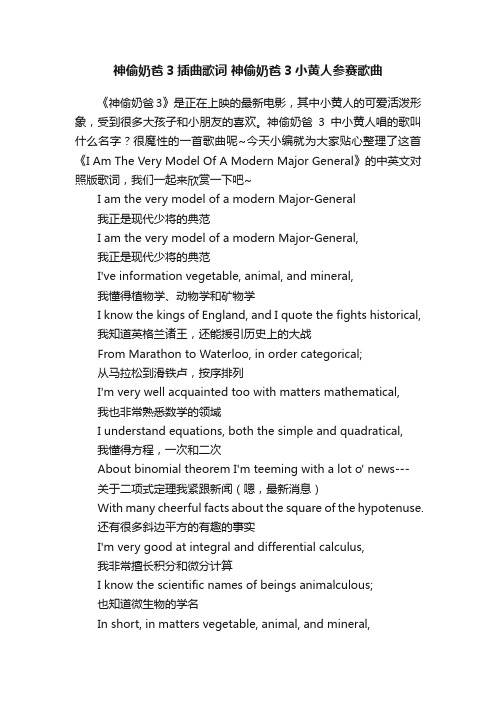
神偷奶爸3插曲歌词神偷奶爸3小黄人参赛歌曲《神偷奶爸3》是正在上映的最新电影,其中小黄人的可爱活泼形象,受到很多大孩子和小朋友的喜欢。
神偷奶爸3中小黄人唱的歌叫什么名字?很魔性的一首歌曲呢~今天小编就为大家贴心整理了这首《I Am The Very Model Of A Modern Major General》的中英文对照版歌词,我们一起来欣赏一下吧~I am the very model of a modern Major-General我正是现代少将的典范I am the very model of a modern Major-General,我正是现代少将的典范I've information vegetable, animal, and mineral,我懂得植物学、动物学和矿物学I know the kings of England, and I quote the fights historical,我知道英格兰诸王,还能援引历史上的大战From Marathon to Waterloo, in order categorical;从马拉松到滑铁卢,按序排列I'm very well acquainted too with matters mathematical,我也非常熟悉数学的领域I understand equations, both the simple and quadratical,我懂得方程,一次和二次About binomial theorem I'm teeming with a lot o' news---关于二项式定理我紧跟新闻(嗯,最新消息)With many cheerful facts about the square of the hypotenuse.还有很多斜边平方的有趣的事实I'm very good at integral and differential calculus,我非常擅长积分和微分计算I know the scientific names of beings animalculous;也知道微生物的学名In short, in matters vegetable, animal, and mineral,简而言之,论及植物学、动物学和矿物学I am the very model of a modern Major-General.我正是现代少将的典范I know our mythic history, King Arthur's and Sir Caradoc's,我知道我国神话历史,亚瑟王和卡拉多克爵士I answer hard acrostics, I've a pretty taste for paradox,我能回答藏头诗,还对悖论颇有研究I quote in elegiacs all the crimes of Heliogabalus,我以哀歌双行体援引埃拉伽巴路斯的所有罪孽In conics I can floor peculiarities parablous.论圆锥曲线我还能算出抛物线的奇特属性I can tell undoubted Raphaels from Gerard Dows and Zoffanies,我可以十分确定地区分出拉斐尔、格里特德奥和佐法尼I know the croaking chorus from the Frogs of Aristophanes,我知道阿里斯托芬的蛙的粗粝合唱声音And whistle all the airs from that infernal nonsense Pinafore.我还能靠以前听过的曲调哼出对应的曲调(dinafore,dinafore。
电影金刚狼3主题曲歌词分享
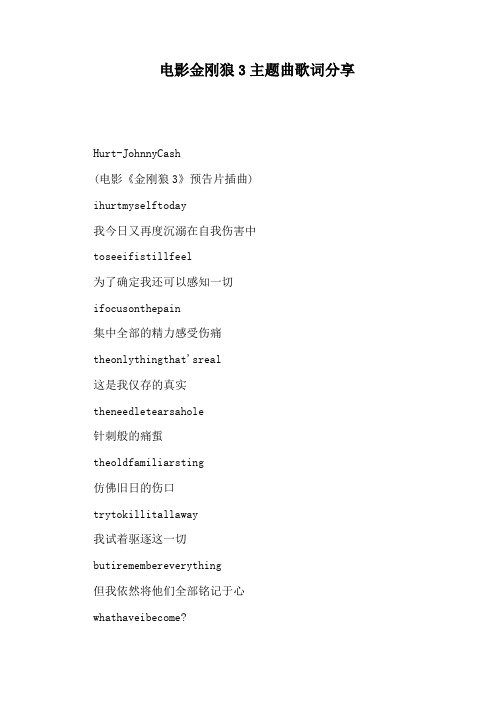
电影金刚狼3主题曲歌词分享Hurt-JohnnyCash(电影《金刚狼3》预告片插曲)ihurtmyselftoday我今日又再度沉溺在自我伤害中toseeifistillfeel为了确定我还可以感知一切ifocusonthepain集中全部的精力感受伤痛theonlythingthat'sreal这是我仅存的真实theneedletearsahole针刺般的痛蜇theoldfamiliarsting仿佛旧日的伤口trytokillitallaway我试着驱逐这一切butiremembereverything但我依然将他们全部铭记于心whathaveibecome?什么又是我本来的相貌呢mysweetestfriend我最亲爱的朋友everyoneiknow而我熟知的一切goesawayintheend皆已经消失远去youcouldhaveitall你远远胜于myempireofdirt我在这肮脏尘世中所争夺的一切iwillletyoudown而我恐于只会让你失望iwillmakeyouhurt只会让你受伤害iwearmycrownofshit当我背负荆棘制成的王冠onmyliar'schair在由谎言构筑的王座上安坐fullofbrokenthoughts但那一切破碎满溢的思绪icannotrepair我却无法弥补beneaththestainoftime世界在时光的冲刷下褪去本来的颜色thefeelingdisappears我的知觉已经麻木youaresomeoneelse当你的灵魂走进人海iamstillrighthere而我却无法再前进一步whathaveibecome?什么又是我本来的相貌呢mysweetestfriend我最重要的朋友everyoneiknow如今我熟知的一切goesawayintheend皆已消逝远去youcouldhaveitall你远远胜于myempireofdirt我在这肮脏尘世中所争夺的一切iwillletyoudown而我只会辜负你的期望iwillmakeyouhurt让你受到伤害ificouldstartagain如果有一天我可以让这一切重新开始amillionmilesaway我会踏遍整个世界iwouldkeepmyself保留着那个真实的自我iwouldfindaway继续寻找那条灵魂的路让世界毁灭-林宥嘉(电影《金刚狼3:殊死一战》推广曲)一座一座乐园一块一块剥落倾斜我被碾成了碎片一页一页回忆不知不觉泛起焦黑遗忘发生了病变时间越来越慢拒绝载我到未来雨越来越酸走来的路都腐烂光越来越暗谁把希望全都关上就让世界毁灭就让一切化成灰一切荒谬今天都终结就让我被毁灭作个废人无所谓不过是又回到了原点一堆一堆昨天一层一层破灭粉碎我在黑洞的边缘一片一片黑夜无声无息逼我撤退等着看我掉眼泪时间越来越慢拒绝载我到未来雨越来越酸走来的路都腐烂光越来越暗谁把希望全都关上就让世界毁灭就让一切化成灰一切荒谬今天都终结就让我被毁灭就让骄傲的骨灰来证明我曾经是谁就让一切化成灰一切荒谬今天都终结就让世界毁灭就让一切化成灰一切荒谬今天都终结就让我被毁灭作个废人无所谓不过是又回到了原点。
极限特工3终极回归主题曲歌词

极限特工3终极回归主题曲歌词导读:All the Way Up (Remix)- Fat Joe / French Montana / InfaRed / Remy Ma / David Guetta / Glowinthedark(电影《极限特工:终极回归》预告片插曲)Nothing can stop me I'm all the way up我势不可挡,我旗开得胜All the way up势不可挡I'm all the way up我势不可挡I'm all the way up我无人能敌Nothing can stop me I'm all the way up我无人能挡,我旗开得胜Shorty what you want shorty what you need妹子你要干嘛你想干嘛My niggas run the game we ain't ever leavin'我们主宰一切从未失势Countin' up this money we ain't never sleepin'数不完的钱彻夜狂欢You got v12 I got 12 v's你有引擎我却有豪车Got bottles got weed got molly觥筹交错烟雾萦绕妹子相伴I'm all the way up我无人能及Shorty what you want I got what you need 妹子你想要什么我就有什么Nothing can stop me I'm all the way up我无人能挡无人能敌Nothing can stop me I'm all the way up我无人能挡无人能敌All the way up无人能及I'm all the way up我无人能及I'm all the way up我无人能敌Nothing can stop me I'm all the way up我无人能挡,我旗开得胜Just left the big house to a bigger house房子越换越大Ain't have a girlfriend but the bitch is out我没有女友只有进进出出的妹子Chanel croc bag shit ain't even out想要香奈儿鳄鱼包却还没发售With the gold chains himalayan birkin' cocaine脖带着金链手夹比尔克香烟Lit it up pac shit I hit 'em up抽着香烟我就是焦点I'm talkin' color money purple yen and blue dirham 我有各色各样的钱紫色日元蓝色摩洛哥币I got brown lira I ain't talkin' 'bout ross bitch 我有棕色发的里拉不是上次的罗斯I'm that nigga on viagra dick我精力旺盛That means I'm all the way up我意思是我无人能挡Shorty what you want I got what you need妹子你想要什么我就有什么I'm all the way up我无人能及Nothing can stop me I'm all the way up我无人能挡,我旗开得胜Nothing can stop me I'm all the way up我无人能挡,我高高在上Nothing can stop me I'm all the way up我无人能挡,我无法企及Nothing can stop me I'm all the way up我无人能挡,我众生相拥【极限特工3终极回归主题曲歌词】1.《极限特工3:终极回归》观后感「精选」2.2017电影《极限特工:终极回归》观后感3.动作片《极限特工:终极回归》观后感「精选」4.热血经典《极限特工3:终极回归》观后感5.《极限特工:终极回归》观后感6.好莱坞大片《极限特工3:终极回归》观后感7.2017最刺激的好莱坞影片《极限特工3:终极回归》观后感8.前任3主题曲《说散就散》歌词上文是关于极限特工3终极回归主题曲歌词,感谢您的阅读,希望对您有帮助,谢谢。
AESOP_Fables
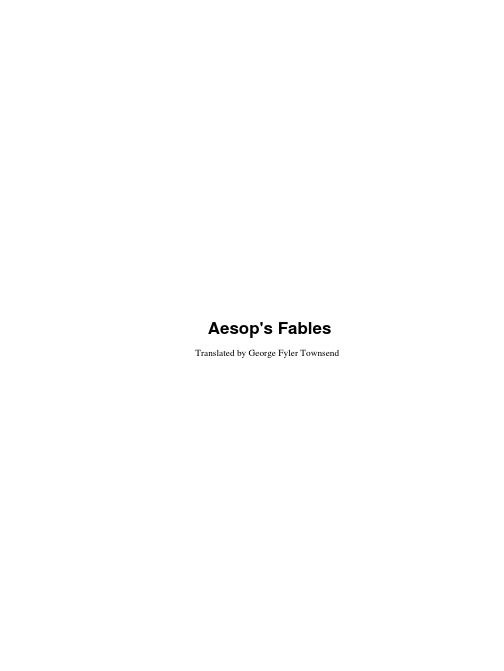
Aesop's Fables Translated by George Fyler TownsendAesop's Fables (1)Translated by George Fyler Townsend (1)Preface (7)The Wolf and the Lamb (11)The Bat and the Weasels (11)The Ass and the Grasshopper (12)The Lion and the Mouse (12)The Charcoal−Burner and the Fuller (12)The Father and His Sons (12)The Boy Hunting Locusts (12)The Cock and the Jewel (12)The Kingdom of the Lion (13)The Wolf and the Crane (13)The Fisherman Piping (13)Hercules and the Wagoner (13)The Ants and the Grasshopper (13)The Traveler and His Dog (13)The Dog and the Shadow (14)The Mole and His Mother (14)The Herdsman and the Lost Bull (14)The Hare and the Tortoise (14)The Pomegranate, Apple−Tree, and Bramble (14)The Farmer and the Stork (15)The Farmer and the Snake (15)The Fawn and His Mother (15)The Bear and the Fox (15)The Swallow and the Crow (15)The Mountain in Labor (15)The Ass, the Fox, and the Lion (16)The Tortoise and the Eagle (16)The Flies and the Honey−Pot (16)The Man and the Lion (16)The Farmer and the Cranes (16)The Dog in the Manger (17)The Fox and the Goat (17)The Bear and the Two Travelers (17)The Oxen and the Axle−Trees (17)The Thirsty Pigeon (18)The Raven and the Swan (18)The Goat and the Goatherd (18)The Miser (18)The Sick Lion (18)The Horse and Groom (19)The Ass and the Lapdog (19)The Lioness (19)The Boasting Traveler (19)The Cat and the Cock (19)The Boy and the Filberts (20)The Lion in Love (20)The Laborer and the Snake (20)The Wolf in Sheep's Clothing (20)The Ass and the Mule (21)The Frogs Asking for a King (21)The Boys and the Frogs (21)The Sick Stag (21)The Salt Merchant and His Ass (21)The Oxen and the Butchers (22)The Lion, the Mouse, and the Fox (22)The Vain Jackdaw (22)The Goatherd and the Wild Goats (22)The Mischievous Dog (23)The Fox Who Had Lost His Tail (23)The Boy and the Nettles (23)The Man and His Two Sweethearts (23)The Astronomer (23)The Wolves and the Sheep (24)The Old Woman and the Physician (24)The Fighting Cocks and the Eagle (24)The Charger and the Miller (24)The Fox and the Monkey (24)The Horse and His Rider (25)The Belly and the Members (25)The Vine and the Goat (25)Jupiter and the Monkey (25)The Widow and Her Little Maidens (25)The Shepherd's Boy and the Wolf (25)The Cat and the Birds (26)The Kid and the Wolf (26)The Ox and the Frog (26)The Shepherd and the Wolf (26)The Father and His Two Daughters (26)The Farmer and His Sons (27)The Crab and Its Mother (27)The Heifer and the Ox (27)The Swallow, the Serpent, and the Court of Justice (27)The Thief and His Mother (27)The Old Man and Death (27)The Fir−Tree and the Bramble (28)The Mouse, the Frog, and the Hawk (28)The Man Bitten by a Dog (28)The Two Pots (28)The Wolf and the Sheep (28)The Aethiop (29)The Fisherman and His Nets (29)The Old Woman and the Wine−Jar (29)The Fox and the Crow (29)The Two Dogs (30)The Stag in the Ox−Stall (30)The Hawk, the Kite, and the Pigeons (30)The Widow and the Sheep (30)The Wild Ass and the Lion (31)The Eagle and the Arrow (31)The Sick Kite (31)The Lion and the Dolphin (31)The Lion and the Boar (31)The One−Eyed Doe (32)The Shepherd and the Sea (32)The Ass, the Cock, and the Lion (32)The Mice and the Weasels (32)The Mice in Council (32)The Wolf and the Housedog (33)The Rivers and the Sea (33)The Playful Ass (33)The Three Tradesmen (33)The Master and His Dogs (33)The Wolf and the Shepherds (33)The Dolphins, the Whales, and the Sprat (34)The Ass Carrying the Image (34)The Two Travelers and the Axe (34)The Old Lion (34)The Old Hound (34)The Bee and Jupiter (34)The Milk−Woman and Her Pail (35)The Seaside Travelers (35)The Brazier and His Dog (35)The Ass and His Shadow (35)The Ass and His Masters (36)The Oak and the Reeds (36)The Fisherman and the Little Fish (36)The Hunter and the Woodman (36)The Wild Boar and the Fox (36)The Lion in a Farmyard (37)Mercury and the Sculptor (37)The Swan and the Goose (37)The Swollen Fox (37)The Fox and the Woodcutter (37)The Birdcatcher, the Partridge, and the Cock (38)The Monkey and the Fishermen (38)The Flea and the Wrestler (38)The Two Frogs (38)The Cat and the Mice (38)The Doe and the Lion (39)The Farmer and the Fox (39)The Seagull and the Kite (39)The Philosopher, the Ants, and Mercury (39)The Mouse and the Bull (39)The Lion and the Hare (40)The Peasant and the Eagle (40)The Image of Mercury and the Carpenter (40)The Bull and the Goat (40)The Dancing Monkeys (40)The Monkeys and Their Mother (41)The Oaks and Jupiter (41)The Hare and the Hound (41)The Traveler and Fortune (41)The Bald Knight (41)The Shepherd and the Dog (41)The Lamp (42)The Lion, the Fox, and the Ass (42)The Bull, the Lioness, and the Wild−Boar Hunter (42)The Oak and the Woodcutters (42)The Hen and the Golden Eggs (42)The Ass and the Frogs (42)The Crow and the Raven (43)The Trees and the Axe (43)The Crab and the Fox (43)The Woman and Her Hen (43)The Ass and the Old Shepherd (43)The Kites and the Swans (44)The Wolves and the Sheepdogs (44)The Hares and the Foxes (44)The Bowman and Lion (44)The Camel (44)The Wasp and the Snake (44)The Dog and the Hare (45)The Bull and the Calf (45)The Stag, the Wolf, and the Sheep (45)The Peacock and the Crane (45)The Fox and the Hedgehog (45)The Eagle, the Cat, and the Wild Sow (46)The Thief and the Innkeeper (46)The Mule (46)The Hart and the Vine (46)The Serpent and the Eagle (47)The Crow and the Pitcher (47)The Two Frogs (47)The Wolf and the Fox (47)The Walnut−Tree (47)The Monkey and the Dolphin (48)The Jackdaw and the Doves (48)The Horse and the Stag (48)The Kid and the Wolf (48)The Prophet (48)The Fox and the Monkey (49)The Thief and the Housedog (49)The Man, the Horse, the Ox, and the Dog (49)The Apes and the Two Travelers (49)The Wolf and the Shepherd (50)The Hares and the Lions (50)The Lark and Her Young Ones (50)The Fox and the Lion (50)The Weasel and the Mice (50)The Boy Bathing (51)The Ass and the Wolf (51)The Seller of Images (51)The Fox and the Grapes (51)The Man and His Wife (51)The Peacock and Juno (52)The Hawk and the Nightingale (52)The Dog, the Cock, and the Fox (52)The Wolf and the Goat (52)The Lion and the Bull (52)The Goat and the Ass (53)The Town Mouse and the Country Mouse (53)The Wolf, the Fox, and the Ape (53)The Fly and the Draught−Mule (53)The Fishermen (53)The Lion and the Three Bulls (54)The Fowler and the Viper (54)The Horse and the Ass (54)The Fox and the Mask (54)The Geese and the Cranes (54)The Blind Man and the Whelp (54)The Dogs and the Fox (55)The Cobbler Turned Doctor (55)The Wolf and the Horse (55)The Brother and the Sister (55)The Wasps, the Partridges, and the Farmer (55)The Crow and Mercury (56)The North Wind and the Sun (56)The Two Men Who Were Enemies (56)The Gamecocks and the Partridge (56)The Quack Frog (56)The Lion, the Wolf, and the Fox (57)The Dog's House (57)The Birds, the Beasts, and the Bat (57)The Spendthrift and the Swallow (57)The Fox and the Lion (57)The Owl and the Birds (58)The Trumpeter Taken Prisoner (58)The Ass in the Lion's Skin (58)The Sparrow and the Hare (58)The Flea and the Ox (58)The Goods and the Ills (58)The Dove and the Crow (59)Mercury and the Workmen (59)The Eagle and the Jackdaw (59)The Fox and the Crane (59)Jupiter, Neptune, Minerva, and Momus (60)The Eagle and the Fox (60)The Man and the Satyr (60)The Ass and His Purchaser (60)The Two Bags (61)The Stag at the Pool (61)The Jackdaw and the Fox (61)The Lark Burying Her Father (61)The Gnat and the Bull (61)The Bitch and Her Whelps (61)The Dogs and the Hides (62)The Shepherd and the Sheep (62)The Grasshopper and the Owl (62)The Monkey and the Camel (62)The Peasant and the Apple−Tree (62)The Two Soldiers and the Robber (63)The Trees Under the Protection of the Gods (63)The Mother and the Wolf (63)The Ass and the Horse (63)Truth and the Traveler (63)The Cat and Venus (65)The She−Goats and Their Beards (65)The Camel and the Arab (66)The Miller, His Son, and Their Ass (66)The Crow and the Sheep (66)The Fox and the Bramble (66)The Wolf and the Lion (66)The Dog and the Oyster (67)The Ant and the Dove (67)The Partridge and the Fowler (67)The Flea and the Man (67)The Thieves and the Cock (67)The Dog and the Cook (67)The Travelers and the Plane−Tree (68)The Lion, Jupiter, and the Elephant (68)The Lamb and the Wolf (68)The Rich Man and the Tanner (69)The Shipwrecked Man and the Sea (69)The Mules and the Robbers (69)The Viper and the File (69)The Lion and the Shepherd (69)The Camel and Jupiter (69)The Panther and the Shepherds (70)The Ass and the Charger (70)The Eagle and His Captor (70)The Bald Man and the Fly (70)The Olive−Tree and the Fig−Tree (70)The Eagle and the Kite (71)The Ass and His Driver (71)The Thrush and the Fowler (71)The Rose and the Amaranth (71)The Frogs' Complaint Against the Sun (71)LIFE OF AESOP (71)Aesop's FablesTranslated by George Fyler Townsend This page copyright © 2001 Blackmask Online.•PrefaceThe Wolf and the Lamb••The Bat and the Weasels•The Ass and the Grasshopper•The Lion and the Mouse•The Charcoal−Burner and the Fuller•The Father and His Sons•The Boy Hunting Locusts•The Cock and the Jewel•The Kingdom of the Lion•The Wolf and the Crane•The Fisherman Piping•Hercules and the Wagoner•The Ants and the Grasshopper•The Traveler and His Dog•The Dog and the ShadowThe Mole and His Mother••The Herdsman and the Lost Bull•The Hare and the Tortoise•The Pomegranate, Apple−Tree, and Bramble•The Farmer and the Stork•The Farmer and the Snake•The Fawn and His Mother•The Bear and the Fox•The Swallow and the Crow•The Mountain in Labor•The Ass, the Fox, and the Lion•The Tortoise and the Eagle•The Flies and the Honey−Pot•The Man and the Lion•The Farmer and the Cranes•The Dog in the Manger•The Fox and the Goat•The Bear and the Two Travelers•The Oxen and the Axle−Trees•The Thirsty Pigeon•The Raven and the SwanThe Goat and the Goatherd••The Miser•Aesop's Fables The Ass and the Lapdog••The Lioness•The Boasting TravelerThe Cat and the Cock•The Piglet, the Sheep, and the Goat•The Boy and the Filberts•The Lion in Love•The Laborer and the Snake•The Wolf in Sheep's Clothing••The Ass and the MuleThe Frogs Asking for a King•The Boys and the Frogs•The Sick Stag•The Salt Merchant and His Ass•The Oxen and the Butchers••The Lion, the Mouse, and the FoxThe Vain Jackdaw•The Goatherd and the Wild Goats••The Mischievous DogThe Fox Who Had Lost His Tail•The Boy and the Nettles••The Man and His Two SweetheartsThe Astronomer•The Wolves and the Sheep••The Old Woman and the PhysicianThe Fighting Cocks and the Eagle••The Charger and the Miller•The Fox and the MonkeyThe Horse and His Rider•The Belly and the Members•The Vine and the Goat•Jupiter and the Monkey•The Widow and Her Little Maidens•The Shepherd's Boy and the Wolf••The Cat and the BirdsThe Kid and the Wolf•The Ox and the Frog•The Shepherd and the Wolf•The Father and His Two Daughters•The Farmer and His Sons••The Crab and Its MotherThe Heifer and the Ox•The Swallow, the Serpent, and the Court of Justice••The Thief and His MotherThe Old Man and Death•The Fir−Tree and the Bramble••The Mouse, the Frog, and the HawkThe Man Bitten by a Dog•The Two Pots••The Fisherman and His Nets••The Huntsman and the Fisherman•The Old Woman and the Wine−Jar•The Fox and the Crow•The Two Dogs•The Stag in the Ox−StallThe Hawk, the Kite, and the Pigeons••The Widow and the Sheep•The Wild Ass and the LionThe Eagle and the Arrow••The Sick Kite•The Lion and the Dolphin•The Lion and the Boar•The One−Eyed Doe•The Shepherd and the SeaThe Ass, the Cock, and the Lion••The Mice and the Weasels•The Mice in Council•The Wolf and the Housedog•The Rivers and the Sea•The Playful Ass•The Three Tradesmen•The Master and His Dogs•The Wolf and the Shepherds•The Dolphins, the Whales, and the Sprat •The Ass Carrying the Image•The Two Travelers and the Axe•The Old LionThe Old Hound••The Bee and Jupiter•The Milk−Woman and Her Pail•The Seaside Travelers•The Brazier and His Dog•The Ass and His Shadow•The Ass and His Masters•The Oak and the ReedsThe Fisherman and the Little Fish••The Hunter and the WoodmanThe Wild Boar and the Fox••The Lion in a Farmyard•Mercury and the SculptorThe Swan and the Goose••The Swollen Fox•The Fox and the Woodcutter•The Birdcatcher, the Partridge, and the Cock •The Monkey and the Fishermen•The Flea and the Wrestler•The Two Frogs•The Cat and the Mice•The Lion, the Bear, and the FoxThe Farmer and the Fox••The Seagull and the Kite•The Philosopher, the Ants, and Mercury•The Mouse and the Bull•The Lion and the Hare•The Peasant and the EagleThe Image of Mercury and the Carpenter••The Bull and the Goat•The Dancing MonkeysThe Monkeys and Their Mother••The Oaks and Jupiter•The Hare and the Hound•The Traveler and Fortune•The Bald Knight•The Shepherd and the DogThe Lamp••The Lion, the Fox, and the Ass•The Bull, the Lioness, and the Wild−Boar Hunter •The Oak and the Woodcutters•The Hen and the Golden Eggs•The Ass and the Frogs•The Crow and the Raven•The Trees and the Axe•The Crab and the Fox•The Woman and Her Hen•The Ass and the Old Shepherd•The Kites and the Swans•The Wolves and the SheepdogsThe Hares and the Foxes••The Bowman and Lion•The Camel•The Wasp and the Snake•The Dog and the Hare•The Bull and the Calf•The Stag, the Wolf, and the Sheep•The Peacock and the CraneThe Fox and the Hedgehog••The Eagle, the Cat, and the Wild SowThe Thief and the Innkeeper••The Mule•The Hart and the VineThe Serpent and the Eagle••The Crow and the Pitcher•The Two Frogs•The Wolf and the Fox•The Walnut−Tree•The Gnat and the Lion•The Monkey and the Dolphin•The Jackdaw and the Doves•The Horse and the StagThe Prophet••The Fox and the Monkey•The Thief and the Housedog•The Man, the Horse, the Ox, and the Dog •The Apes and the Two Travelers•The Wolf and the ShepherdThe Hares and the Lions••The Lark and Her Young Ones•The Fox and the LionThe Weasel and the Mice••The Boy Bathing•The Ass and the Wolf•The Seller of Images•The Fox and the Grapes•The Man and His WifeThe Peacock and Juno••The Hawk and the Nightingale•The Dog, the Cock, and the Fox•The Wolf and the Goat•The Lion and the Bull•The Goat and the Ass•The Town Mouse and the Country Mouse •The Wolf, the Fox, and the Ape•The Fly and the Draught−Mule•The Fishermen•The Lion and the Three Bulls•The Fowler and the Viper•The Horse and the AssThe Fox and the Mask••The Geese and the Cranes•The Blind Man and the Whelp•The Dogs and the Fox•The Cobbler Turned Doctor•The Wolf and the Horse•The Brother and the Sister•The Wasps, the Partridges, and the Farmer The Crow and Mercury••The North Wind and the SunThe Two Men Who Were Enemies••The Gamecocks and the Partridge•The Quack FrogThe Lion, the Wolf, and the Fox••The Dog's House•The Wolf and the Lion•The Birds, the Beasts, and the Bat•The Spendthrift and the Swallow•The Fox and the Lion•The Owl and the Birds•The Trumpeter Taken Prisoner•The Ass in the Lion's SkinThe Flea and the Ox••The Goods and the Ills•The Dove and the Crow•Mercury and the Workmen•The Eagle and the Jackdaw•The Fox and the CraneJupiter, Neptune, Minerva, and Momus ••The Eagle and the Fox•The Man and the SatyrThe Ass and His Purchaser••The Two Bags•The Stag at the Pool•The Jackdaw and the Fox•The Lark Burying Her Father•The Gnat and the BullThe Bitch and Her Whelps••The Dogs and the Hides•The Shepherd and the Sheep•The Grasshopper and the Owl•The Monkey and the Camel•The Peasant and the Apple−Tree•The Two Soldiers and the Robber•The Trees Under the Protection of the Gods •The Mother and the Wolf•The Ass and the Horse•Truth and the Traveler•The Cat and Venus•The She−Goats and Their BeardsThe Camel and the Arab••The Miller, His Son, and Their Ass•The Crow and the Sheep•The Fox and the Bramble•The Wolf and the Lion•The Dog and the Oyster•The Ant and the Dove•The Partridge and the FowlerThe Flea and the Man••The Thieves and the CockThe Dog and the Cook••The Travelers and the Plane−Tree•The Hares and the FrogsThe Lion, Jupiter, and the Elephant••The Lamb and the Wolf•The Rich Man and the Tanner•The Shipwrecked Man and the Sea•The Mules and the Robbers•The Viper and the File•The Lion and the Shepherd•The Camel and Jupiter•The Panther and the Shepherds•The Eagle and His Captor•The Bald Man and the Fly•The Olive−Tree and the Fig−Tree•The Eagle and the KiteThe Ass and His Driver••The Thrush and the Fowler•The Rose and the AmaranthThe Frogs' Complaint Against the Sun••LIFE OF AESOPPrefaceTHE TALE, the Parable, and the Fable are all common and popular modes of conveying instruction. Each is distinguished by its own special characteristics. The Tale consists simply in the narration of a story either founded on facts, or created solely by the imagination, and not necessarily associated with the teaching of any moral lesson. The Parable is the designed use of language purposely intended to convey a hidden and secret meaning other than that contained in the words themselves; and which may or may not bear a special reference to the hearer, or reader. The Fable partly agrees with, and partly differs from both of these. It will contain, like the Tale, a short but real narrative; it will seek, like the Parable, to convey a hidden meaning, and that not so much by the use of language, as by the skilful introduction of fictitious characters; and yet unlike to either Tale or Parable, it will ever keep in view, as its high prerogative, and inseparable attribute, the great purpose of instruction, and will necessarily seek to inculcate some moral maxim, social duty, or political truth. The true Fable, if it rise to its high requirements, ever aims at one great end and purpose representation of human motive, and the improvement of human conduct, and yet it so conceals its design under the disguise of fictitious characters, by clothing with speech the animals of the field, the birds of the air, the trees of the wood, or the beasts of the forest, that the reader shall receive advice without perceivingthe presence of the adviser. Thus the superiority of the counsellor, which often renders counsel unpalatable, is kept out of view, and the lesson comes with the greater acceptance when the reader is led, unconsciously to himself, to have his sympathies enlisted in behalf of what is pure, honorable, and praiseworthy, and to havehis indignation excited against what is low, ignoble, and unworthy. The true fabulist, therefore, discharges a most important function. He is neither a narrator, nor an allegorist. He is a great teacher, a corrector of morals, a censor of vice, and a commender of virtue. In this consists the superiority of the Fable over the Tale or the Parable. The fabulist is to create a laugh, but yet, under a merry guise, to convey instruction. Phaedrus, the great imitator of Aesop, plainly indicates this double purpose to be the true office of the writer of fables.Duplex libelli dos est: quod risum movet,Et quod prudenti vitam consilio monet.The continual observance of this twofold aim creates the charm, and accounts for the universal favor, of the fables of Aesop. "The fable," says Professor K. O. Mueller, "originated in Greece in an intentional travestieof human affairs. The 'ainos,' as its name denotes, is an admonition, or rather a reproof veiled, either from fear of an excess of frankness, or from a love of fun and jest, beneath the fiction of an occurrence happening among beasts; and wherever we have any ancient and authentic account of the Aesopian fables, we find it to be the same." lThe construction of a fable involves a minute attention to (1) the narration itself; (2) the deduction of the moral; and (3) a careful maintenance of the individual characteristics of the fictitious personages introduced into it. The narration should relate to one simple action, consistent with itself, and neither be overladen with aand so intimately interwoven with, and so necessarily dependent on, the narration, that every reader should be compelled to give to it the same undeniable interpretation. The introduction of the animals or fictitious characters should be marked with an unexceptionable care and attention to their natural attributes, and to the qualities attributed to them by universal popular consent. The Fox should be always cunning, the Hare timid, the Lion bold, the Wolf cruel, the Bull strong, the Horse proud, and the Ass patient. Many of these fables are characterized by the strictest observance of these rules. They are occupied with one short narrative, from which the moral naturally flows, and with which it is intimately associated. "'Tis the simple manner," says Dodsley, 2 "in which the morals of Aesop are interwoven with his fables that distinguishes him, and gives him the preference over all other mythologists. His 'Mountain delivered of a Mouse,' produces the moral of his fable in ridicule of pompous pretenders; and his Crow, when she drops her cheese, lets fall, as it were by accident, the strongest admonition against the power of flattery. There is no need of a separate sentence to explain it; no possibility of impressing it deeper, by that load we too often see of accumulated reflections." 3 An equal amount of praise is due for the consistency with which the characters of the animals, fictitiously introduced, are marked. While they are made to depict the motives and passions of men, they retain, in an eminent degree, their own special features of craft or counsel, of cowardice or courage, of generosity or rapacity.These terms of praise, it must be confessed, cannot be bestowed on all the fables in this collection. Many of them lack that unity of design, that close connection of the moral with the narrative, that wise choice in the introduction of the animals, which constitute the charm and excellency of true Aesopian fable. This inferiority of some to others is sufficiently accounted for in the history of the origin and descent of these fables. The great bulk of them are not the immediate work of Aesop. Many are obtained from ancient authors prior to the time in which he lived. Thus, the fable of the "Hawk and the Nightingale" is related by Hesiod; 4 the "Eagle wounded by an Arrow, winged with its own Feathers," by Aeschylus; 5 the "Fox avenging his wrongs on the Eagle," by Archilochus. 6 Many of them again are of later origin, and are to be traced to the monks of the middle ages: and yet this collection, though thus made up of fables both earlier and later than the era of Aesop, rightfully bears his name, because he composed so large a number (all framed in the same mould, and conformed to the same fashion, and stamped with the same lineaments, image, and superscription) as to secure to himself the right to be considered the father of Greek fables, and the founder of this class of writing, which has ever since borne his name, and has secured for him, through all succeeding ages, the position of the first of moralists.7The fables were in the first instance only narrated by Aesop, and for a long time were handed down by the uncertain channel of oral tradition. Socrates is mentioned by Plato 8 as having employed his time while in prison, awaiting the return of the sacred ship from Delphos which was to be the signal of his death, in turning some of these fables into verse, but he thus versified only such as he remembered. Demetrius Phalereus, a philosopher at Athens about 300 B.C., is said to have made the first collection of these fables. Phaedrus, a slave by birth or by subsequent misfortunes, and admitted by Augustus to the honors of a freedman, imitated many of these fables in Latin iambics about the commencement of the Christian era. Aphthonius, a rhetorician of Antioch, A.D. 315, wrote a treatise on, and converted into Latin prose, some of these fables. This translation is the more worthy of notice, as it illustrates a custom of common use, both in these and in later times. The rhetoricians and philosophers were accustomed to give the Fables of Aesop as an exercise to their scholars, not only inviting them to discuss the moral of the tale, but also to practice and to perfect themselves thereby in style and rules of grammar, by making for themselves new and various versions of the fables. Ausonius, 9 the friend of the Emperor Valentinian, and the latest poet of eminence in the Western Empire, has handed down some of these fables in verse, which Julianus Titianus, a contemporary writer of no great name, translated into prose. Avienus, also a contemporary of Ausonius, put some of these fables into Latin elegiacs, which are given by Nevelet (in a book we shall refer to hereafter), and are occasionally incorporated with the editions of Phaedrus.。
极限特工3:终极回归电影主题曲片尾曲里面所有歌曲歌词音乐原声MV(3).doc
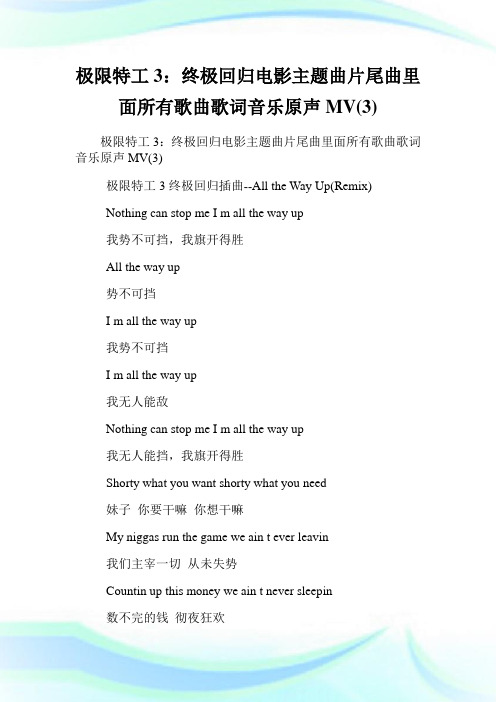
极限特工3:终极回归电影主题曲片尾曲里面所有歌曲歌词音乐原声MV(3)极限特工3:终极回归电影主题曲片尾曲里面所有歌曲歌词音乐原声MV(3)极限特工3终极回归插曲--All the Way Up(Remix)Nothing can stop me I m all the way up我势不可挡,我旗开得胜All the way up势不可挡I m all the way up我势不可挡I m all the way up我无人能敌Nothing can stop me I m all the way up我无人能挡,我旗开得胜Shorty what you want shorty what you need妹子你要干嘛你想干嘛My niggas run the game we ain t ever leavin我们主宰一切从未失势Countin up this money we ain t never sleepin数不完的钱彻夜狂欢You got v12 I got 12 v s你有引擎我却有豪车Got bottles got weed got molly觥筹交错烟雾萦绕妹子相伴I m all the way up我无人能及Shorty what you want I got what you need 妹子你想要什么我就有什么Nothing can stop me I m all the way up 我无人能挡无人能敌Nothing can stop me I m all the way up 我无人能挡无人能敌All the way up无人能及I m all the way up我无人能及I m all the way up我无人能敌Nothing can stop me I m all the way up 我无人能挡,我旗开得胜Just left the big house to a bigger house 房子越换越大Ain t have a girlfriend but the bitch is out我没有女友只有进进出出的妹子Chanel croc bag shit ain t even out想要香奈儿鳄鱼包却还没发售With the gold chains himalayan birkin cocaine脖带着金链手夹比尔克香烟Lit it up pac shit I hit em up抽着香烟我就是焦点I m talkin color money purple yen and blue dirham 我有各色各样的钱紫色日元蓝色摩洛哥币I got brown lira I ain t talkin bout ross bitch我有棕色发的里拉不是上次的罗斯I m that nigga on viagra dick我精力旺盛That means I m all the way up我意思是我无人能挡Shorty what you want I got what you need妹子你想要什么我就有什么I m all the way up我无人能及Nothing can stop me I m all the way up我无人能挡,我旗开得胜Nothing can stop me I m all the way up 我无人能挡,我高高在上Nothing can stop me I m all the way up 我无人能挡,我无法企及Nothing can stop me I m all the way up 我无人能挡,我众生相拥。
生化危机6终章主题曲歌词_1
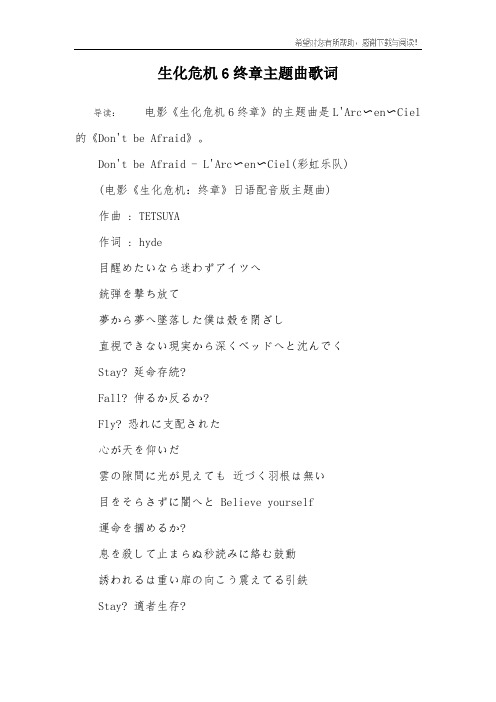
生化危机6终章主题曲歌词导读:电影《生化危机6终章》的主题曲是L'Arc〜en〜Ciel 的《Don't be Afraid》。
Don't be Afraid - L'Arc〜en〜Ciel(彩虹乐队)(电影《生化危机:终章》日语配音版主题曲)作曲 : TETSUYA作词 : hyde目醒めたいなら迷わずアイツへ銃弾を撃ち放て夢から夢へ墜落した僕は殼を閉ざし直視できない現実から深くベッドへと沈んでくStay? 延命存続?Fall? 伸るか反るか?Fly? 恐れに支配された心が天を仰いだ雲の隙間に光が見えても近づく羽根は無い目をそらさずに闇へと Believe yourself運命を摑めるか?息を殺して止まらぬ秒読みに絡む鼓動誘われるは重い扉の向こう震えてる引鉄Stay? 適者生存?Cry? 現実界でLaugh? 最後にもう一度だけ自分を信じてみるあの日の僕が目の前を塞いで“不可能”とあざ笑う目醒めたいならアイツへ Embrace your fate銃弾を撃ち放て雲の隙間に光が見えても近づく羽根は無い暗闇の向こう Don't be afraid, believe yourself運命を摑み取れ【生化危机6终章主题曲歌词】1.2017生化危机6终章主题曲歌词2.生化危机6终章观后感「精选」3.2017观《生化危机6:终章》有感4.《生化危机6:终章》观后感「荐」5.《生化危机6:终章》观后感大全6.生化动作巨制《生化危机终章》观后感7.2017《生化危机:终章》观后感8.关于电影《生化危机:终章》观后感上文是关于生化危机6终章主题曲歌词,感谢您的阅读,希望对您有帮助,谢谢。
金刚狼3主题曲、插曲、片尾曲、背景音乐所有歌曲mv歌词

金刚狼3主题曲、插曲、片尾曲、背景音乐所有歌曲mv歌词金刚狼3是由詹姆斯·曼高德执导,休·杰克曼、达芙妮·基恩、帕特里克·斯图尔特、波伊德·霍布鲁克等联合主演。
那么你知道金刚狼3主题曲插曲片尾曲背景音乐谁唱的吗?下面是有金刚狼3所有歌曲mv歌词,欢迎参阅。
金刚狼3主题曲、插曲、片尾曲、背景音乐所有歌曲mv歌词金刚狼3剧情介绍科幻悬疑巨制《金刚狼3》是《金刚狼》的第三篇,而它亦有可能是《金刚狼》系列的最终章。
17年前,从《X战警》开始,休杰克曼便带上长长的利爪,开始演绎金刚狼充满传奇的一生。
金刚狼无法炮制的成功也让他成为变种人的一个代名词。
金刚狼,一个犹如野兽般存在的,拥有超强的自愈能力,天性中自带的刚烈劣性,可由体内伸出的利爪的变种人。
而17年的时间都在演绎同一个角色,这让休杰克曼产生了倦意。
如今46岁的休杰克曼将最后一次带上金刚狼充满劣性的爪子,最后一次演绎金刚狼。
金刚狼将定格在46岁的休杰克曼身上,让金刚狼的最后身影将留在休杰克曼最美好的年华里。
或许,往后的日子里亦有同样出彩的人演绎金刚狼,但是时至今日,最经典的的休杰克曼版金刚狼却只能在过去的影片和记忆中找寻了。
《金刚狼3》将继续由詹姆斯•曼高德担任导演,《普罗米修斯2》的编剧迈克尔•格林将执笔编写,目前还处于剧本的撰写阶段,预计于2016年初开拍。
在金刚狼息影前又将面临什么样的灾难呢?金刚狼传奇的一生将画上什么样的句点呢?休•杰克曼将用怎样的方式完结自己的金刚狼生涯?最后的休杰克曼,最后的金刚狼,尽在2017年3月3日上映的《金刚狼3》。
电影金刚狼3演员表詹姆斯·豪利特/罗根 (休·杰克曼饰)金刚狼,超级英雄,拥有急速自愈能力,野兽般的感知能力,天生双臂长有可伸出体外的利爪,但是却失去了实验醒来前所有的记忆。
在加拿大惹上一身麻烦后,来自日本的神秘男子“禅”找到他,并告诉他如果想知道自己身世之谜就前往东京。
黑客帝国3片尾曲中文翻译
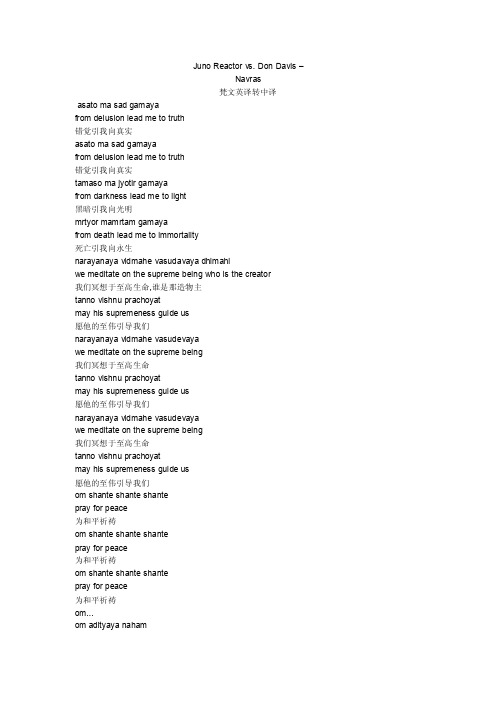
Juno Reactor vs. Don Davis –Navras梵文英译转中译asato ma sad gamayafrom delusion lead me to truth错觉引我向真实asato ma sad gamayafrom delusion lead me to truth错觉引我向真实tamaso ma jyotir gamayafrom darkness lead me to light黑暗引我向光明mrtyor mamrtam gamayafrom death lead me to immortality死亡引我向永生narayanaya vidmahe vasudavaya dhimahiwe meditate on the supreme being who is the creator我们冥想于至高生命,谁是那造物主tanno vishnu prachoyatmay his supremeness guide us愿他的至伟引导我们narayanaya vidmahe vasudevayawe meditate on the supreme being我们冥想于至高生命tanno vishnu prachoyatmay his supremeness guide us愿他的至伟引导我们narayanaya vidmahe vasudevayawe meditate on the supreme being我们冥想于至高生命tanno vishnu prachoyatmay his supremeness guide us愿他的至伟引导我们om shante shante shantepray for peace为和平祈祷om shante shante shantepray for peace为和平祈祷om shante shante shantepray for peace为和平祈祷om...om adityaya nahamsalutations to the son of the cosmic mother对寰宇之母圣子的款待om adityaya nahamsalutations to the son of the cosmic mother对寰宇之母圣子的款待om adityaya nahamsalutations to the son of the cosmic mother对寰宇之母圣子的款待asato ma sad gamayafrom delusion lead me to truth错觉引我向真实asato ma sad gamayafrom delusion lead me to truth错觉引我向真实tamaso ma jyotir gamayafrom darkness lead me to light黑暗引我向光明narayanaya vidmahe vasudavaya dhimahiwe meditate on the supreme being who is the creator 我们冥想于至高生命,谁是那造物主tanno vishnu prachoyatmay his supremeness guide us愿他的至伟引导我们narayanaya vidmahe vasudevayawe meditate on the supreme being我们冥想于至高生命tanno vishnu prachoyatmay his supremeness guide us愿他的至伟引导我们om shante shante shantepray for peace为和平祈祷om shante shante shantepray for peace为和平祈祷om shante shante shantepray for peace为和平祈祷om...jnanani manasa sahathe mind are still思想静止buddhis ca na vicestateand reason itself rests in silence因憩于沉寂tam ahuh paramam gatimthen begins the path supreme然后开始那至伟的路ya ya ya ya yada yadayaya ya ya ya yada yada yada yadayada yada yada yada yada梵文意译从虚幻带领我到现实,从黑暗指引我到光明,从死亡超度我到不朽。
金刚狼3主题曲、插曲、片尾曲、背景音乐所有歌曲mv歌词
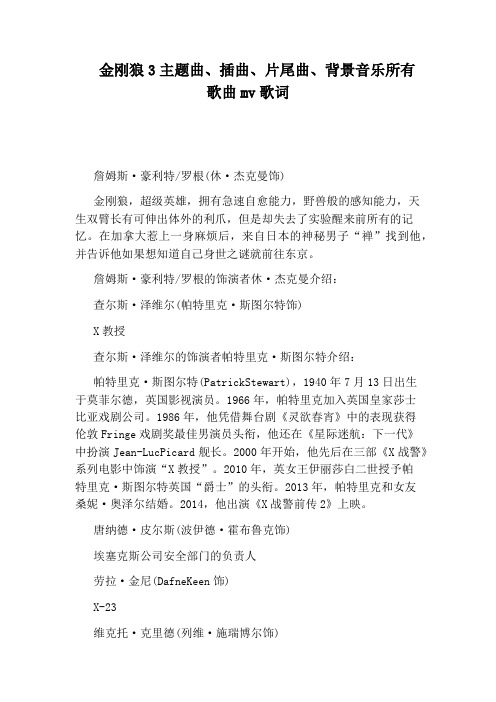
金刚狼3主题曲、插曲、片尾曲、背景音乐所有歌曲mv歌词詹姆斯·豪利特/罗根(休·杰克曼饰)金刚狼,超级英雄,拥有急速自愈能力,野兽般的感知能力,天生双臂长有可伸出体外的利爪,但是却失去了实验醒来前所有的记忆。
在加拿大惹上一身麻烦后,来自日本的神秘男子“禅”找到他,并告诉他如果想知道自己身世之谜就前往东京。
詹姆斯·豪利特/罗根的饰演者休·杰克曼介绍:查尔斯·泽维尔(帕特里克·斯图尔特饰)X教授查尔斯·泽维尔的饰演者帕特里克·斯图尔特介绍:帕特里克·斯图尔特(PatrickStewart),1940年7月13日出生于莫菲尔德,英国影视演员。
1966年,帕特里克加入英国皇家莎士比亚戏剧公司。
1986年,他凭借舞台剧《灵欲春宵》中的表现获得伦敦Fringe戏剧奖最佳男演员头衔,他还在《星际迷航:下一代》中扮演Jean-LucPicard舰长。
2000年开始,他先后在三部《X战警》系列电影中饰演“X教授”。
2010年,英女王伊丽莎白二世授予帕特里克·斯图尔特英国“爵士”的头衔。
2013年,帕特里克和女友桑妮·奥泽尔结婚。
2014,他出演《X战警前传2》上映。
唐纳德·皮尔斯(波伊德·霍布鲁克饰)埃塞克斯公司安全部门的负责人劳拉·金尼(DafneKeen饰)X-23维克托·克里德(列维·施瑞博尔饰)剑齿虎HotelGuest(辛西娅·李·布兰科饰)酒店客人(客串)纳撒尼尔·埃塞克斯(未知饰)惊恶先生赞德·赖斯(理查德·格兰特饰)卡利班(斯戴芬·莫昌特饰)未知(伊莉丝·尼尔饰)未知(伊丽莎白·罗德里格斯饰)未知(艾瑞克·拉塞里饰)>>>点击下一页阅读更多关于金刚狼3主题曲、插曲、片尾曲、背景音乐所有歌曲mv歌词。
猩球崛起3插曲、主题曲、片尾曲、背景音乐、所有歌曲歌词MV
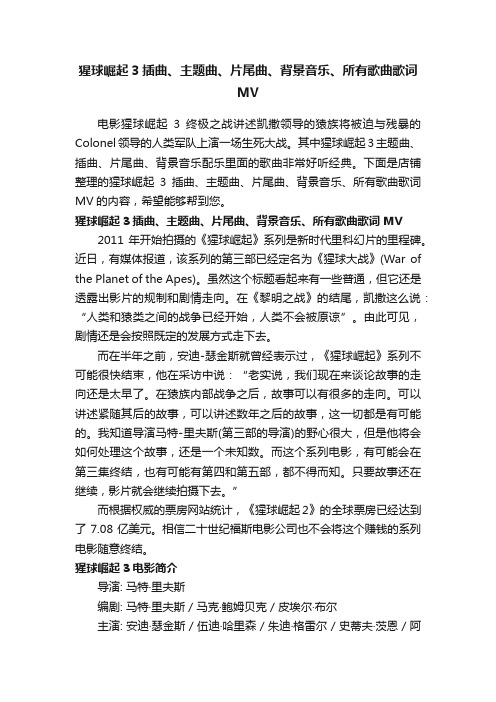
猩球崛起3插曲、主题曲、片尾曲、背景音乐、所有歌曲歌词MV电影猩球崛起3终极之战讲述凯撒领导的猿族将被迫与残暴的Colonel领导的人类军队上演一场生死大战。
其中猩球崛起3主题曲、插曲、片尾曲、背景音乐配乐里面的歌曲非常好听经典。
下面是店铺整理的猩球崛起3插曲、主题曲、片尾曲、背景音乐、所有歌曲歌词MV的内容,希望能够帮到您。
猩球崛起3插曲、主题曲、片尾曲、背景音乐、所有歌曲歌词MV 2011年开始拍摄的《猩球崛起》系列是新时代里科幻片的里程碑。
近日,有媒体报道,该系列的第三部已经定名为《猩球大战》(War of the Planet of the Apes)。
虽然这个标题看起来有一些普通,但它还是透露出影片的规制和剧情走向。
在《黎明之战》的结尾,凯撒这么说:“人类和猿类之间的战争已经开始,人类不会被原谅”。
由此可见,剧情还是会按照既定的发展方式走下去。
而在半年之前,安迪-瑟金斯就曾经表示过,《猩球崛起》系列不可能很快结束,他在采访中说:“老实说,我们现在来谈论故事的走向还是太早了。
在猿族内部战争之后,故事可以有很多的走向。
可以讲述紧随其后的故事,可以讲述数年之后的故事,这一切都是有可能的。
我知道导演马特-里夫斯(第三部的导演)的野心很大,但是他将会如何处理这个故事,还是一个未知数。
而这个系列电影,有可能会在第三集终结,也有可能有第四和第五部,都不得而知。
只要故事还在继续,影片就会继续拍摄下去。
”而根据权威的票房网站统计,《猩球崛起2》的全球票房已经达到了7.08亿美元。
相信二十世纪福斯电影公司也不会将这个赚钱的系列电影随意终结。
猩球崛起3电影简介导演: 马特·里夫斯编剧: 马特·里夫斯 / 马克·鲍姆贝克 / 皮埃尔·布尔主演: 安迪·瑟金斯 / 伍迪·哈里森 / 朱迪·格雷尔 / 史蒂夫·茨恩 / 阿莱克斯·潘诺维奇类型: 剧情 / 动作 / 科幻 / 冒险制片国家/地区: 美国语言: 英语上映日期: 2017-07-14(美国)又名: 猿人争霸战:猩凶巨战(港) / 猩球大战:猿力觉醒(豆友译名) / 猩球崛起3 / 人猿猩球3 /猩球崛起电影上映时间美国上映时间:2017-07-14比利时 2017年7月12日荷兰 2017年7月13日土耳其 2017年7月14日猩球崛起人物角色介绍凯撒演员安迪-瑟金斯演举世闻名的猩猩首领。
- 1、下载文档前请自行甄别文档内容的完整性,平台不提供额外的编辑、内容补充、找答案等附加服务。
- 2、"仅部分预览"的文档,不可在线预览部分如存在完整性等问题,可反馈申请退款(可完整预览的文档不适用该条件!)。
- 3、如文档侵犯您的权益,请联系客服反馈,我们会尽快为您处理(人工客服工作时间:9:00-18:30)。
金刚狼3主题曲插曲片尾曲背景音乐MV歌词
美国出品的动作奇幻冒险片《金刚狼3》将于2017年3月3日
登陆中国各大院线上映。
该片片长未知。
由演员休·杰克曼、帕特
里克·斯图尔特、波伊德·霍布鲁克、斯戴芬·莫昌特、辛西
亚·勒布朗、RonaldJoeVasquez、TonyBeard、杰伊·奥利弗、多瑞丝·莫加多、伊丽莎白·罗德里格斯、朱莉娅·霍特等主演。
如今46岁的休杰克曼将最后一次带上金刚狼充满劣性的爪子,
最后一次演绎金刚狼。
金刚狼将定格在46岁的休杰克曼身上,让金
刚狼的最后身影将留在休杰克曼最美好的年华里。
或许,往后的日
子里亦有同样出彩的人演绎金刚狼,但是时至今日,最经典的的休
杰克曼版金刚狼却只能在过去的影片和记忆中找寻了。
《金刚狼3》将继续由詹姆斯•曼高德担任导演,《普罗米修斯2》的编剧迈克尔•格林将执笔编写,目前还处于剧本的撰写阶段,预计于2016年初
开拍。
在金刚狼息影前又将面临什么样的灾难呢?金刚狼传奇的一生
将画上什么样的句点呢?休•杰克曼将用怎样的方式完结自己的金刚
狼生涯?最后的休杰克曼,最后的金刚狼,尽在2017年3月3日上
映的《金刚狼3》。
>>>点击下一页阅读更多关于金刚狼3主题曲插曲片尾曲背景音
乐MV歌词。
